Table of Contents
The British Coastline offers various plants species, including wildflowers, lichens and seaweeds found along cliffs, dunes, and shores. The UK also offers the occasional algal bloom seen in coastal waters. An example of this occurred off of Scotlands west coast around the Isle of Arran in June of 2021. Scientists believe the sudden change in colour to turquoise suggests a coccolithophore bloom resulting in the sea colour change.
Algae
Coral Weed
Coral weed is a type of seaweed distinguished by its pink colour and calcareous, branching fronds. It is generally small, growing to a height of 12 cm.
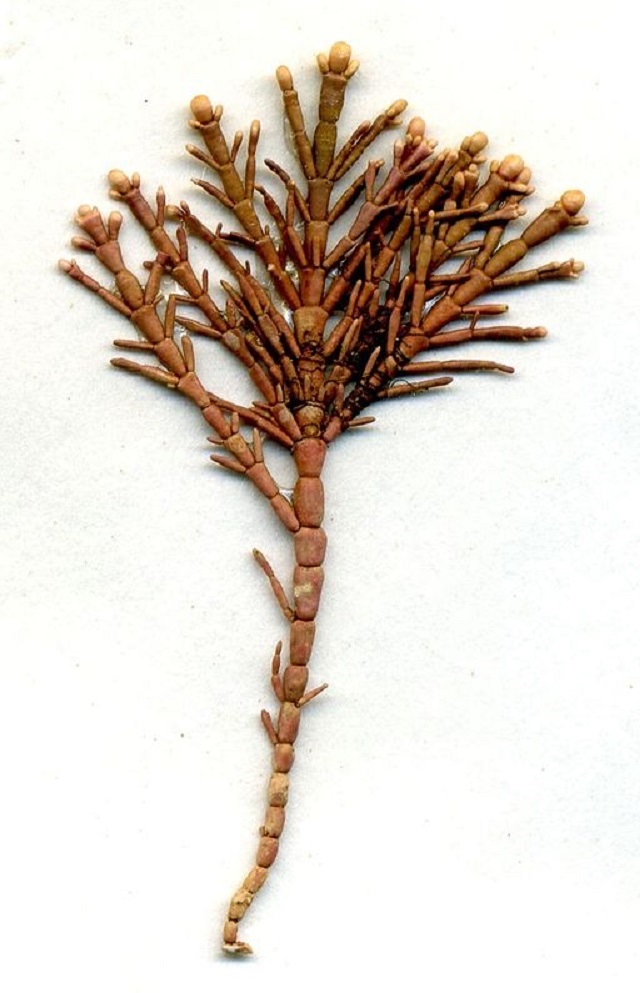
Photo: Gabriele Kothe-Heinrich, CC BY-SA 3.0, via Wikimedia Commons
| Latin Name | Corallina officinalis |
| Best time to see | May to August. |
| Distribution | Coral weed is distributed right around the UK coast. |
| Habitat | Most common in rockpools on the middle to lower shore, although can be found to depths of 33 m. |
| Reproduction: | Reproduces sexually, via gametes produced in small nodules. |
| Uses | Skin care. Cosmetics. |
| Interesting fact | Large numbers of microorganisms live within the fronds of coral weed, making it a very important habitat for the larger marine species which feed on them. |
Egg-wrack
Egg-wrack is a large seaweed species, characterised by having long fronds with egg-shaped air bladders at regular intervals. It is generally dark brown in colour and can grow to 2 m long.

Photo: Dozens at en.wikipedia, CC BY-SA 3.0, via Wikimedia Commons
| Latin Name | Ascophyllum nodosum |
| Best time to see | June to September. |
| Distribution | Egg-wrack can be found right around the UK coastline. |
| Habitat | Inter-tidal regions on sheltered shores are preferred, especially around rocky areas. |
| Reproduction: | Reproduces sexually, via gametes produced in small pockets. |
| Uses | Fertiliser, Food. |
| Interesting fact | Individual fronds of egg-wrack can live for up to 15 years before breaking, with the plants themselves sometimes reaching several decades in age. |
Furbellow Kelp
As the largest seaweed species in the UK, furbellow kelp can grow to 2.5 m long. It is dark brown and leathery, with a warty anchor at its base and large, frilly fronds.
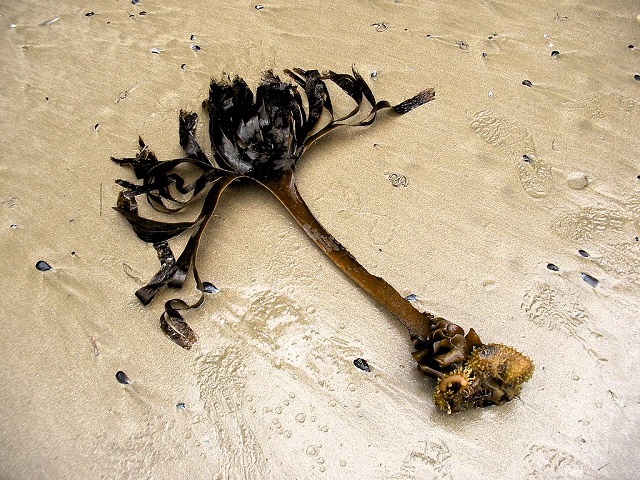
Baralloco, CC BY-SA 3.0, via Wikimedia Commons
| Latin Name | Saccorhiza polyschides |
| Best time to see | June to September. |
| Distribution | Furbellow kelp is found on most UK coastlines, although is far more common in western regions. |
| Habitat | Lives in tidal regions down to depths of about 35 m, where it favours rocky habitats in sheltered waters. |
| Reproduction: | Reproduces asexually, by producing zoospores. |
| Uses | Food |
| Interesting fact | The shape of furbellow kelp fronds varies depending on the environment. In areas of low current, the fronds are flat and non-divided, whereas in areas of strong current they are divided into many strands. Peacock’s Tail |
Peacock’s Tail
The peacock’s tail is a small seaweed that grows to around 10 cm in length. Is is curled and funnel-shaped, and is generally light blue or silver in colour.

Photo : Matthieu Sontag, Licence CC-BY-SA.
| Latin Name | Padina pavonica |
| Best time to see | June to September. |
| Distribution | Peacock’s tails are mainly found on the southern coasts of England and Wales, although some live as far north as southern Scotland. |
| Habitat | Prefers sandy or silty substrates, often around seagrass meadows or in rockpools. |
| Reproduction: | Reproduces both asexually by producing zoospores, and sexually by merging gametes. |
| Uses | Insect pesticide. |
| Interesting fact | Fronds of peacock’s tails grow annually, producing spores during the autumn. Individual fronds can produce as many as 7,500 spores in one season. |
Trentepohlia aurea
Trentepohlia aurea is a species of filamentous green algae, although is it usually bright orange in colour. It grows as a thin carpet.
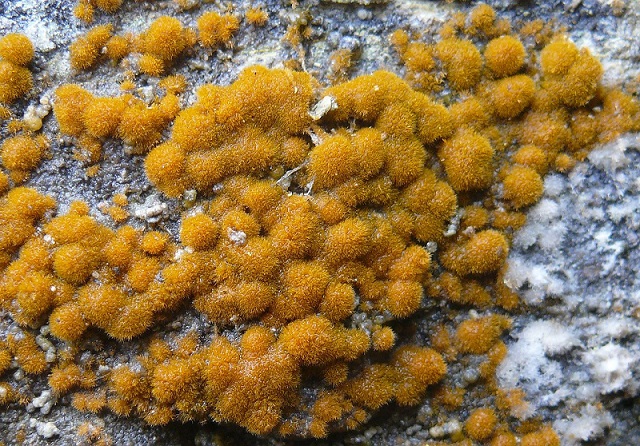
Photo: Bernd Haynold, CC BY-SA 3.0 <https://creativecommons.org/licenses/by-sa/3.0>, via Wikimedia Commons
| Latin Name | Trentepohlia aurea |
| Best time to see | June to September. |
| Distribution | Trentepohlia aurea can be found in many parts of the UK, although is most frequent in north-west Scotland. |
| Habitat | Lives on terrestrial supports such as rocks, tree trunks and walls, especially in coastal areas. |
| Reproduction: | Reproduces asexually by producing zoospores, or sexually by fusing gametes. |
| Uses | Indicators of air pollution levels. |
| Interesting fact | The orange colouration of Trentepohlia aurea is caused by the high density of carotenoid pigments in the algal cells, which mask the green colour of the chlorophyll. |
Fungi
Common Puffball
Common puffballs usually appear as spherical or pear-shaped fungi, covered in short spines. They are white in colour and usually grow to about 6 cm tall.
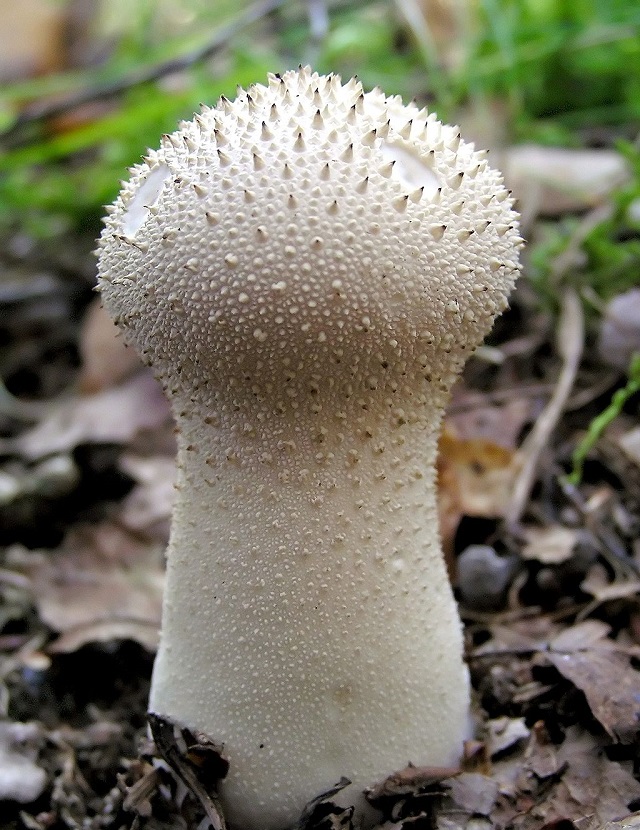
Daniel Ullrich, Threedots, CC BY-SA 3.0, via Wikimedia Commons
| Latin Name | Lycoperdon perlatum |
| Best time to see | August to October. |
| Distribution | The common puffball can be found everywhere in the UK, but tends to be less common in northern Scotland. |
| Habitat | Often grows in woodland areas and grassy habitats such as meadows. |
| Reproduction: | Reproduces both asexually by producing spores, and sexually by fusing gametes. |
| Uses | Food, Indicators of soil pollution. |
| Interesting fact | The common puffball is named for its habit of ejecting clouds of spores when disturbed by raindrops or by passing animals. When it matures, a small hole appears in the cap for this purpose. |
Dune Waxcap
The dune waxcap is a small mushroom, generally reaching around 5 cm tall. It has a yellow stem and a cone-shaped cap that can be red or orange in colour.
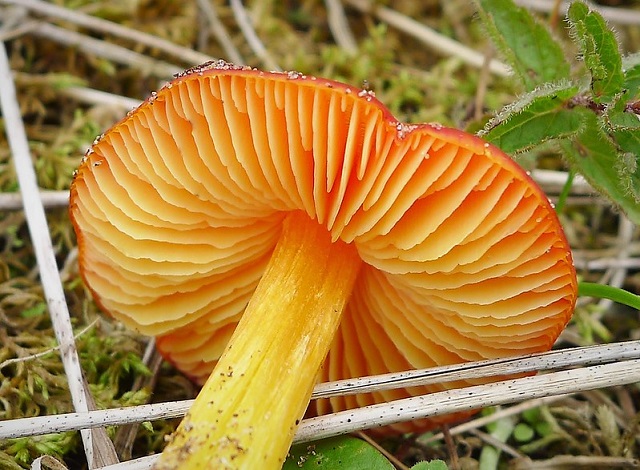
Image source: creative commons licensed (BY-NC-ND) flickr photo by gailhampshire
| Latin Name | Hygrocybe conicoides |
| Best time to see | August to November. |
| Distribution | Dune waxcaps occur right around the UK, although largely in coastal regions. |
| Habitat | Prefers short grass in sandy soils, predominantly around permanent areas of sand dune. |
| Reproduction: | Reproduces both asexually by producing spores, and sexually by fusing gametes. |
| Uses | Food |
| Interesting fact | Due to their dune habitats, dune waxcaps are not commonly eaten by humans, despite being edible. This is because the gills on the undersides of the caps are often heavily laden with sand. |
Fairy Ring Mushroom
Fairy ring mushrooms are light brown in colour and grow to around 7 cm tall. They have small, bell-shaped caps that are usually crowned by central bumps.
| Latin Name | Marasmius oreades |
| Best time to see | July to October. |
| Distribution | Fairy ring mushrooms are widespread in the UK and can be found almost everywhere. |
| Habitat | Lives in grassy areas such as lawns and meadows, although is also common among coastal dunes. |
| Reproduction: | Reproduces both asexually by producing spores, and sexually by fusing gametes. |
| Uses | Food |
| Interesting fact | Fairy ring mushrooms are so-called because they tend to grow in large groups, often forming rings. Traditionally, these rings were thought to be formed by elves or fairies dancing. |
.
Pink Waxcap
The pink waxcap is an agaric mushroom that grows to around 12 cm in height. It has a pale pink cap, which is conical at first but usually splits once it matures. The stem is usually white.

Photo: Lukas Large via flickr
| Latin Name | Porpolomopsis calyptriformis |
| Best time to see | September to November. |
| Distribution | Pink waxcaps are found throughout the UK, although they tend to favour western regions, particularly in Wales. |
| Habitat | Short grassland grazed by cattle is preferred, as well as lawns and churchyards. |
| Reproduction: | Reproduces both asexually by producing spores, and sexually by fusing gametes. |
| Uses | Food |
| Interesting fact | The pink waxcap is also known as the ‘ballerina’, due to its distinctive colour. It was once thought to be very rare in the UK, until conservation publicity caused an upsurge in the number of records. |
Salt-loving Mushroom
The salt-loving mushroom has a large, smooth cap that is usually white in colour. It has pinkish gills beneath the cap and a solid stem that grows to about 6 cm in height.
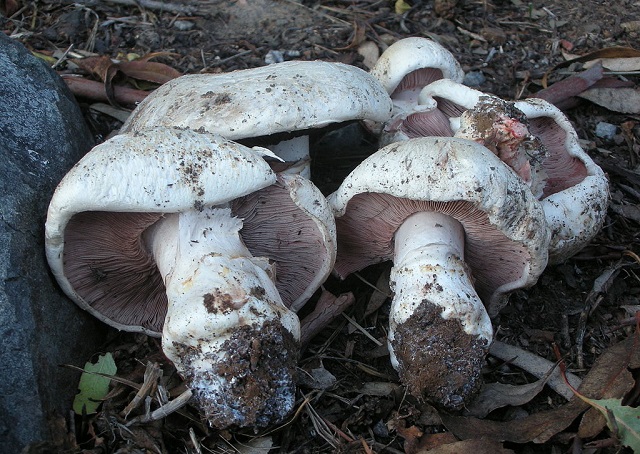
This image was created by user Ron Pastorino (Ronpast) at Mushroom Observer, a source for mycological images.You can contact this user here.English | español | français | italiano | македонски | മലയാളം | português | +/−, CC BY-SA 3.0, via Wikimedia Commons
| Latin Name | Agaricus bernardii |
| Best time to see | July to October. |
| Distribution | Mainly distributed in England and Wales, being more common in southern regions. |
| Habitat | Salt-loving mushrooms are very salt-tolerant, meaning they grow well in coastal habitats such as salt marshes and dunes. |
| Reproduction: | Reproduces both asexually by producing spores, and sexually by fusing gametes. |
| Uses | Food |
| Interesting fact | The salt-loving mushroom is an edible species, said to have an odour that is reminiscent of aniseed and a taste that is slightly salty. |
Tiny Earthstar
The tiny earthstar is brown in colour and is a very small fungus, growing to around 4 cm in height. It is formed of a spore sac, surrounded by an outer casing which splits as it grows, forming a star with several points.
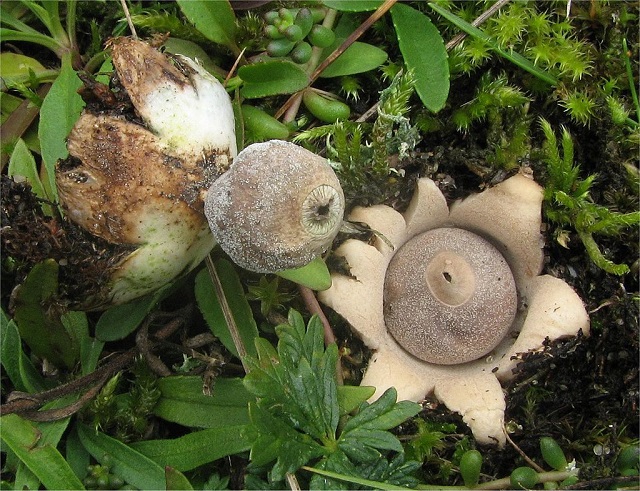
Photo: Irene Andersson (irenea), CC BY-SA 3.0, via Wikimedia Commons
| Latin Name | Geastrum minimum |
| Best time to see | September to November. |
| Distribution | Tiny earthstars are largely restricted to England and Wales, and are found in coastal areas. |
| Habitat | Alkaline sand dune habitats are favoured, especially in ancient dune systems. |
| Reproduction: | Reproduces both asexually by producing spores, and sexually by fusing gametes. |
| Uses | Decoration. |
| Interesting fact | Due to their unusual, octopus-like appearance, tiny earthstars are sometimes collected and dried out, to be used as table decorations. |
Lichens
Ciliate Strap-lichen
The ciliate strap-lichen is a white, branching lichen with distinctive black hairs around each frond. It usually grows in a tangle of about 10 cm in diameter.
| Latin Name | Heterodermia leucomela |
| Best time to see | June to August. |
| Distribution | The ciliate strap-lichen is mainly found in southern parts of the UK, such as south-west England and Wales. |
| Habitat | Occurs almost exclusively on coastal cliffs or rocky outcrops, especially in areas that are exposed or lack soil. |
| Reproduction: | Reproduces asexually, by shedding fragments. |
| Uses | Aesthetic. |
| Interesting fact | The ciliate strap-lichen’s reproductive strategy of fragment shedding is assisted by the wind or by animals such as slugs, which help to transport fragments to new colonisation areas. |
Golden Hair Lichen
The golden hair lichen is a very distinctive species, formed of a clump of finely-divided hair-like structures. It is normally bright orange, although can appear yellowish, and grows to a diameter of 5 cm.
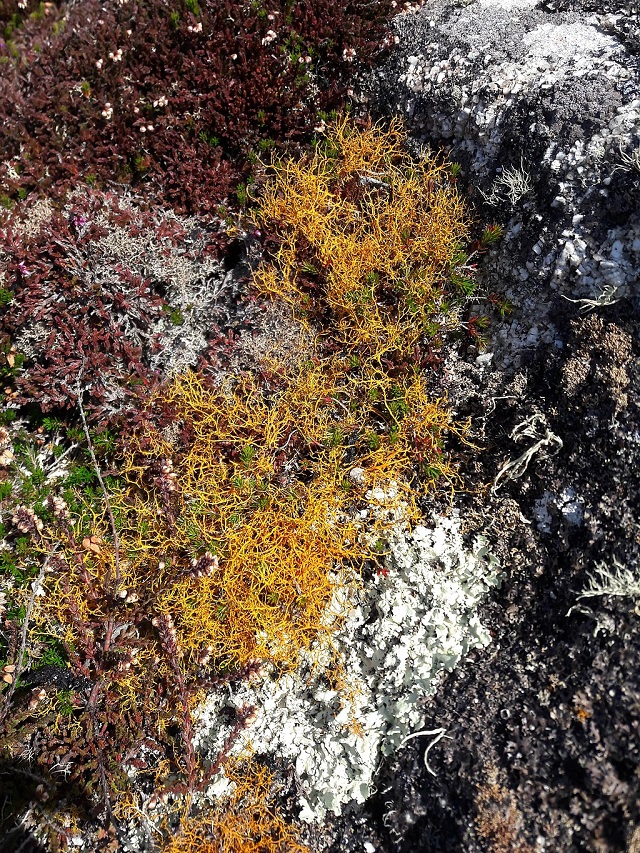
Photo: Jowaninpensans, CC BY-SA 4.0, via Wikimedia Commons
| Latin Name | Teloschistes flavicans |
| Best time to see | June to August. |
| Distribution | Golden hair lichens are mainly restricted to south-west England and Wales, primarily on the coast.coast. |
| Habitat | Sea cliffs are preferred, although it occasionally grows inland in parks and hedgerows, where it can be found on rocks or tree trunks. |
| Reproduction: | Reproduces asexually, by shedding fragments. |
| Uses | Indicators of air pollution. |
| Interesting fact | Golden hair lichens are particularly sensitive to sulphur dioxide in the air. For this reason, the presence of this species can be used to gauge how clean the surrounding air is. |
Ladder Lichen
Ladder lichen grows vertically and is characterised by having tall stalks that widen at the top to form flattened cups. It is usually pale green in colour with red markings, and grows to about 5 cm tall.
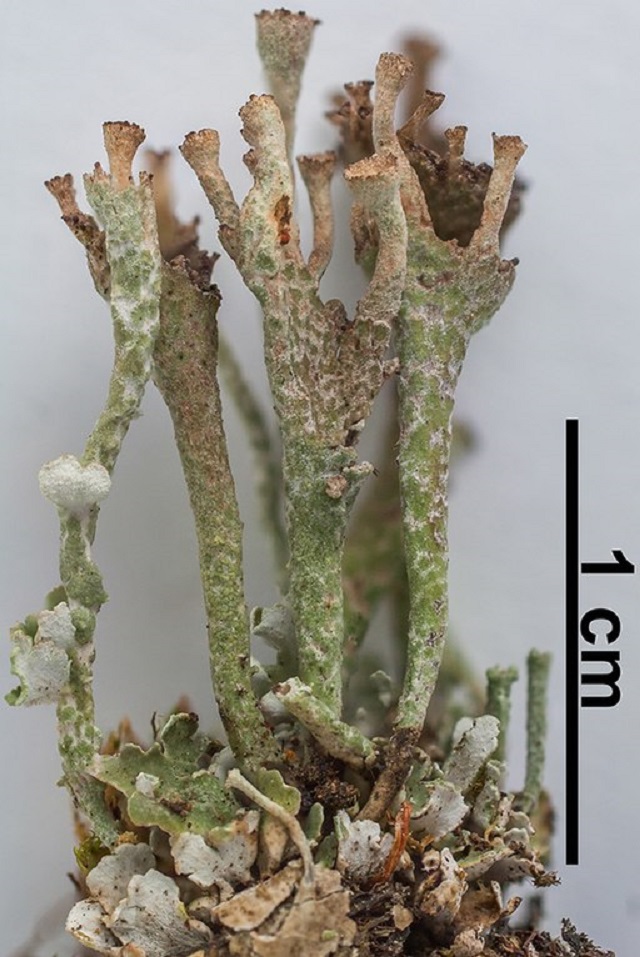
Photo: Mike Guwak., CC BY-SA 3.0 DE, via Wikimedia Commons
| Latin Name | Cladonia cervicornis |
| Best time to see | June to September. |
| Distribution | Ladder lichen is widespread in the UK but is most common in Scotland and Wales. |
| Habitat | Prefers acidic soils in sandy heathland or dunes, but can also be found in dry peatland. |
| Reproduction: | Reproduces both asexually by shedding fragments, as well as sexually by producing spores. |
| Uses | Aesthetic |
| Interesting fact | Ladder lichens do especially well in areas that are prone to fire. There is often a large accumulation of ladder lichens about 4 – 6 years after a big burn. |
Sea Ivory
The sea ivory is a tufted, branched lichen that is usually greyish-green in colour. The branches are flattened and bear disc-shaped, spore-producing bodies.

Photo: Jymm, Public domain, via Wikimedia Commons
| Latin Name | Ramalina siliquosa |
| Best time to see | June to September. |
| Distribution | Sea ivories occur right around the UK coastline, especially in north-west Scotland and Wales. coast. |
| Habitat | Attaches to hard rocks in and around the splash zone by the shore, but also occurs on sea cliffs and rocky beaches. |
| Reproduction: | Reproduces both asexually by shedding fragments, as well as sexually by producing spores. |
| Uses | Aesthetic |
| Interesting fact | Sea ivory is very well adapted to its coastal habitat and can tolerate high levels of salinity and dessication. However, in parts of Scotland and Wales, it is extensively eaten by grazing sheep. |
Yellow Scales
Yellow scales is a species of leafy lichen known for its bright yellow or orange colours. It often appears in large, rounded patches of about 10 cm in diameter, and is wrinkled in appearance.
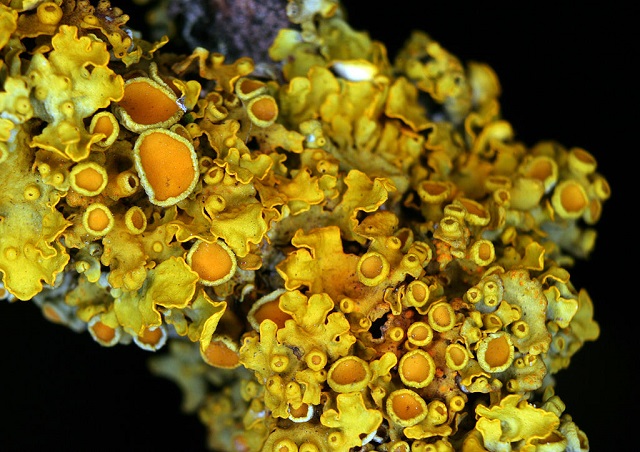
Photo: Holger Krisp, CC BY 3.0, via Wikimedia Commons
| Latin Name | Xanthoria parietina |
| Best time to see | June to August. |
| Distribution | Yellow scales lichen is common throughout the UK, especially on the coast. |
| Habitat | Often found growing on rocks, walls and tree bark, particularly in nutrient-rich sites such as areas beneath bird perches. |
| Reproduction: | Reproduces both asexually by shedding fragments, as well as sexually by producing spores. |
| Uses | Indicator of heavy metal pollution. |
| Interesting fact | The colour of yellow scales lichen is influenced by how much sun it is exposed to. In sunny areas, the lichen produces a yellow chemical to protect against UV rays, while in shaded areas it does not and so appears green. |
Mosses
Blunt Bryum
Blunt bryum is a small, upright moss species that grows to around 2 cm tall. It is known for having wide leaves with blunt tips, and is usually reddish or green in colour. In summer, it sprouts tall spore stems.
| Latin Name | Bryum calophyllum |
| Best time to see | July to September. |
| Distribution | Blunt bryum is rare and patchily distributed in the UK, occurring in a few sites in northern Scotland and Wales. . |
| Habitat | Primarily found on bare sand in mobile sand dune systems by the coast. |
| Reproduction: | Reproduces sexually by producing spores. |
| Uses | Aesthetic |
| Interesting fact | Blunt bryum used to be common in the UK until the 1950’s, when outbreaks of myxomatosis in rabbits resulted in far less bare sand being exposed in dune systems, reducing the available habitat for the species. |
Bog Haircap Moss
Bog haircap moss grows in clumps, with upright stems that look like miniature pine trees. It is generally green with a reddish tinge, and clumps grow to diameters of about 25 cm.
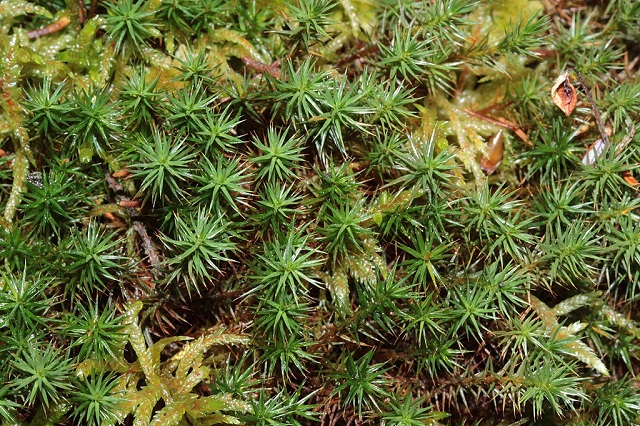
Photo: HermannSchachner, CC0, via Wikimedia Commons
| Latin Name | Polytrichum strictum |
| Best time to see | August to October. |
| Distribution | Bog haircap moss is widespread in Scotland, Wales, Northern Ireland and northern England, but absent in the south. |
| Habitat | Can be seen in boggy peatland in particular, as well as wet heaths and meadows. |
| Reproduction: | Reproduces sexually by producing spores. |
| Uses | Aesthetic |
| Interesting fact | Bog haircap moss often grows on top of other moss species in bog habitats. These regions within the bog have their own microclimate, which the bog haircap moss thrives in. |
Glittering Wood Moss
Distinguished by its feathery, green leaves and pinkish stems, glittering wood moss is a branching moss species. It stays low to ground, with stems that usually grow to around 10 cm long.

Photo: Walter Siegmund, CC BY-SA 3.0, via Wikimedia Commons
| Latin Name | Hylocomium splendens |
| Best time to see | June to September. |
| Distribution | Glittering wood moss is widely found in Scotland, Wales and Northern Ireland, but is scattered elsewhere. |
| Habitat | Lives on acidic substrates such as heathland and bog, although also occurs in woodland habitats. |
| Reproduction: | Reproduces both sexually by fusing gametes, and asexually be shedding fragments |
| Uses | Anti-bacterial. |
| Interesting fact | It is possible to estimate the age of glittering wood mosses by counting the number of ‘steps’ on the fronds. One step is produced each year, allowing the plant to grow and extend across the ground. |
Sandhill Screw-moss
Sandhill screw-moss forms tufts of erect stems that grow to about 4 cm tall. The leaves curve away from the stem, appearing star-like, and are generally green with a red tinge.

Photo: Darkone, CC BY-SA 2.5, via Wikimedia Commons
| Latin Name | Syntrichia ruralis |
| Best time to see | August to October. |
| Distribution | Sandhill screw-moss can be found throughout the UK, but is less common in northern Scotland. |
| Habitat | Grows in a range of habitats, including coniferous woodland, grassland and parks. It is most common on calcareous soils. |
| Reproduction: | Reproduces both asexually by shedding fragments, as well as sexually by fusing gametes. |
| Uses | Aesthetic |
| Interesting fact | Sandhill screw-moss can survive being dried out for years at a time. It does this by entering a dormant state, coming to life again when conditions grow damper. |
Sea Bryum
Sea bryum is a small moss that grows in dense clusters. It is mainly green in colour and can be identified by its tall, fruit-bearing stems, which grow to a height of 1 cm.
| Latin Name | Bryum warneum |
| Best time to see | August to November. |
| Distribution | Sea bryums occur patchily around the UK coast, with most being found in south-west England, Wales and eastern Scotland. |
| Habitat | Moist hollows in sand dune habitats are favoured, especially in nutrient-poor areas. |
| Reproduction: | Reproduces sexually by producing spores. |
| Uses | Aesthetic |
| Interesting fact | Despite being a mainly coastal species in the UK, sea bryum has been found living to very high altitudes in other parts of the world such as the Himalayan Mountains. |
Clubmosses
Fir Clubmoss
Fir clubmosses are small, evergreen plants that are usually yellowish-green in colour. They average 6 cm in height and form several stems which grow upright and are covered in tiny, pointed leaves.
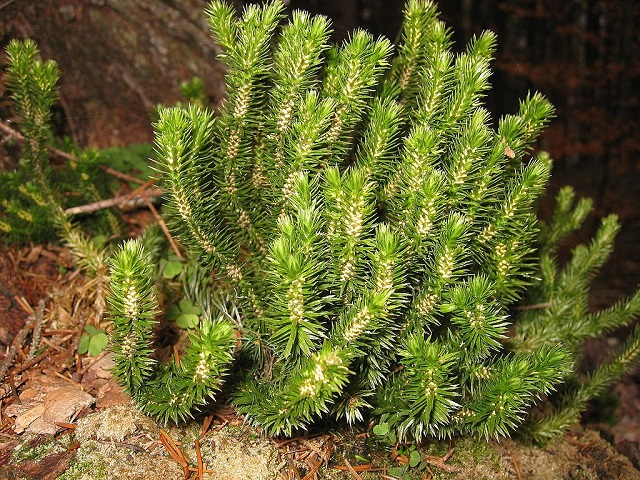
User:Tigerente, CC BY-SA 3.0, via Wikimedia Commons
| Latin Name | Huperzia selago |
| Best time to see | All year-round. |
| Distribution | Fir clubmosses are mainly distributed in Scotland and Wales, although they can also be found in northern England. |
| Habitat | Thrives on acidic, nutrient-poor soils such as peatland, heathland and bog. |
| Reproduction: | Reproduces both sexually by producing spores, as well as asexually by shedding fragments. |
| Uses | Aesthetic |
| Interesting fact | Despite their name, fir clubmosses are more closely related to ferns than true mosses and are one of the simplest forms of plants. |
Ferns
Adder’s Tongue Fern
The adder’s tongue fern is a small, deciduous fern distinguished by having a single frond, from which there grows a pointed spike. It generally reaches 3 cm in height.
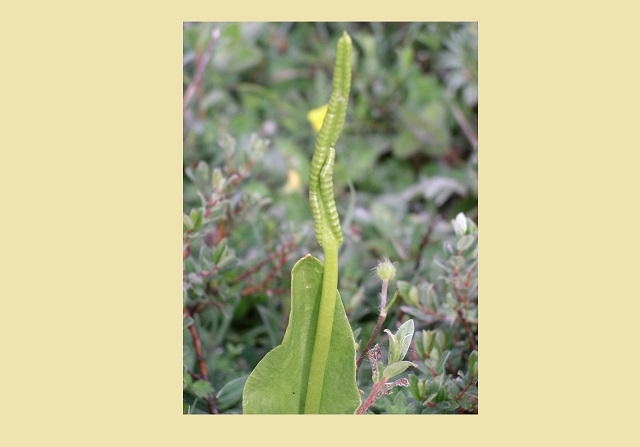
No machine-readable author provided. Velela assumed (based on copyright claims)., Public domain, via Wikimedia Commons
| Latin Name | Ophioglossum azoricum |
| Best time to see | May to August. |
| Distribution | Adder’s tongue ferns are most commonly seen in north-west Scotland, although they also grow in areas of Wales and south-west England. |
| Habitat | Prefers gently sloping grassland and cliff-tops along the coast. Also grows in damp dune-slacks. |
| Reproduction: | Reproduces sexually and asexually by producing spores. |
| Uses | Aesthetic |
| Interesting fact | The pointed spike of the adder’s tongue fern is a spore-producing structure. The spike is segmented, with each segment opening up when ripe to release the spores into the air. |
Common Bracken
Common bracken is a species of fern with large, triangular fronds, which grow individually from a central underground rhizome. They are green in colour and grow to 1 m tall.
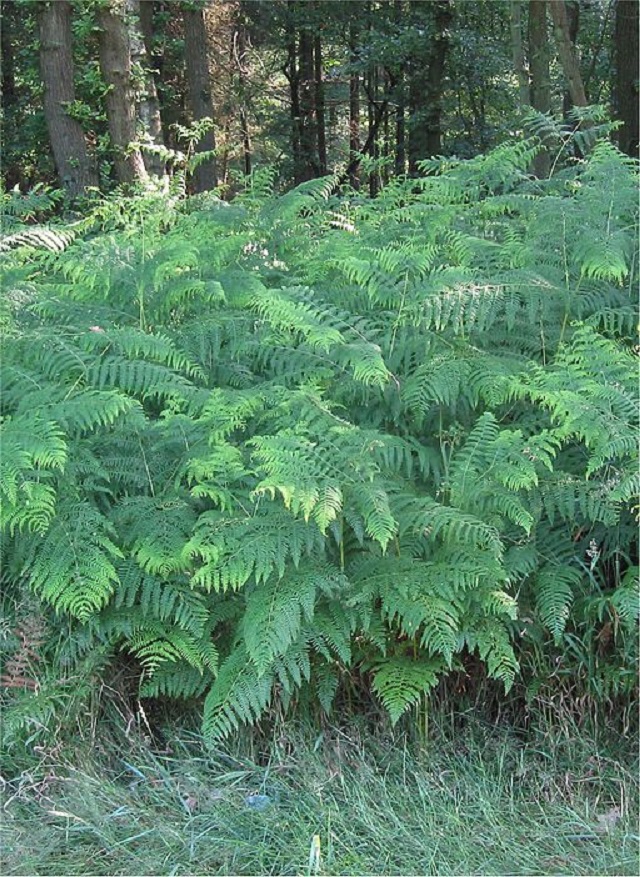
Photo: Rasbak, CC BY-SA 3.0, via Wikimedia Commons
| Latin Name | Pteridium aquilinum |
| Best time to see | May to August. |
| Distribution | Common bracken is found almost everywhere in the UK. |
| Habitat | Often grows on acidic soils in habitats such as heathland, moors and open woodland. It grows especially well in disturbed areas. |
| Reproduction: | Reproduces by spores. |
| Uses | Food |
| Interesting fact | Common bracken, true to its name, is thought to be one of the most common and widespread plants in the world. It is found on every continent except Antarctica. |
Field Horsetail
Field horsetails grow with upright fir tree-like stems that can reach 90 cm in height. They are light green in colour and the leaves are very thin, similar in appearance to hair.
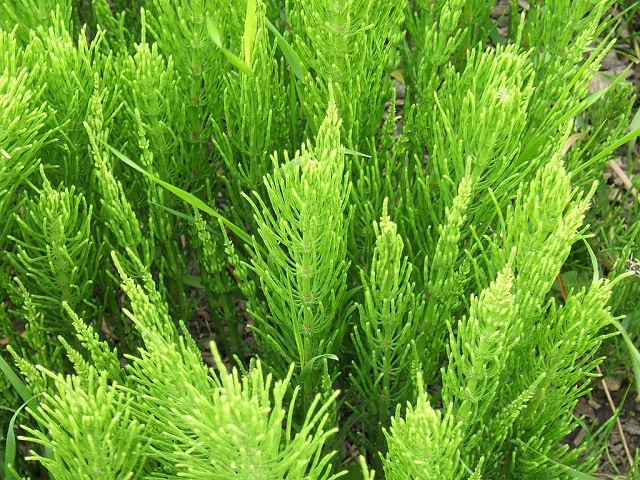
Photo: MPF, CC BY-SA 3.0, via Wikimedia Commons
| Latin Name | Equisetum arvense |
| Best time to see | June to August. |
| Distribution | Field horsetails are very prevalent in the UK and can be found in all regions. |
| Habitat | Grows very well in disturbed habitats such as construction sites and railway lines, but is also common in dune grassland and along river banks. |
| Reproduction: | Reproduces by spores. |
| Uses | Medicine |
| Interesting fact | Field horsetails are extremely persistent and are often a problem for gardeners, as they can be hard to get rid of. The rhizomes of the plant grow very deep down into the ground, meaning the plant is resistant to herbicides. |
Hay-scented Buckler-fern
Hay-scented buckler-ferns are perennial ferns which grow as a crown of fronds, emanating from a thin stem. They are green in colour and grow to heights of about 60 cm.
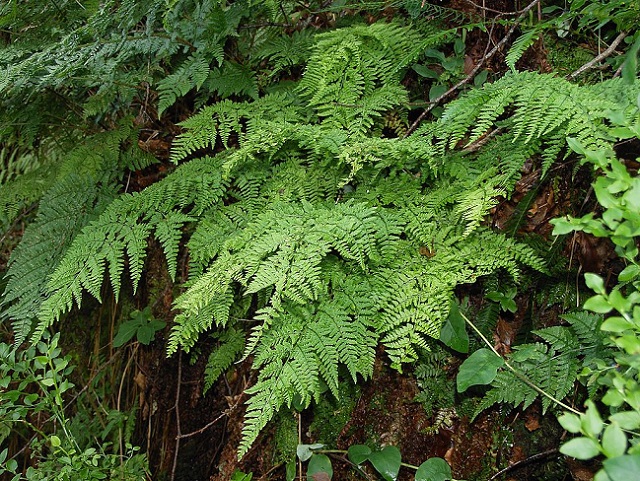
Richtid, CC BY-SA 4.0, via Wikimedia Commons
| Latin Name | Dryopteris aemula |
| Best time to see | June to August. |
| Distribution | Hay-scented buckler-ferns are mainly found on western coasts of the UK, especially in Scotland and south-west England. |
| Habitat | Mainly grows in shaded, damp areas in habitats such as sea-cliffs and wooded slopes. |
| Reproduction: | Reproduces by spores. |
| Uses | Aesthetic |
| Interesting fact | Hence its name, the hay-scented buckler-fern has a smell that is reminiscent of freshly-mown grass. It has special glands on its leaves which produce the scent when disturbed. |
Lanceolate Spleenwort
The lanceolate spleenwort is a small perennial fern with triangular fronds. Fronds grow to about 30 cm long and are green in colour, covered in small leaves that are oval in shape.
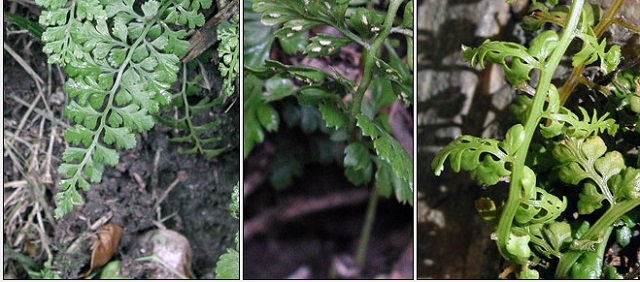
Photo Source: https://www.ukwildflowers.com/
| Latin Name | Asplenium obovatum |
| Best time to see | May to August. |
| Distribution | Lanceolate spleenworts are largely confined to south-western England, although some can be found in Wales. |
| Habitat | Sheltered rock crevices and shady areas are favoured for growing, especially on sea-cliffs and rocky outcrops near the coast. |
| Reproduction: | Reproduces by spores. |
| Uses | Aesthetic |
| Interesting fact | Spleenworts get their name from a historic belief that they could be used to cure ailments affecting the spleen. Despite this belief, there is little scientific evidence to back this theory up. |
Sea Spleenwort
Sea spleenworts are small, low-growing ferns with fronds that reach about 7 cm in length. The fronds are narrow and possess many broad, waxy leaves, which are green in colour.
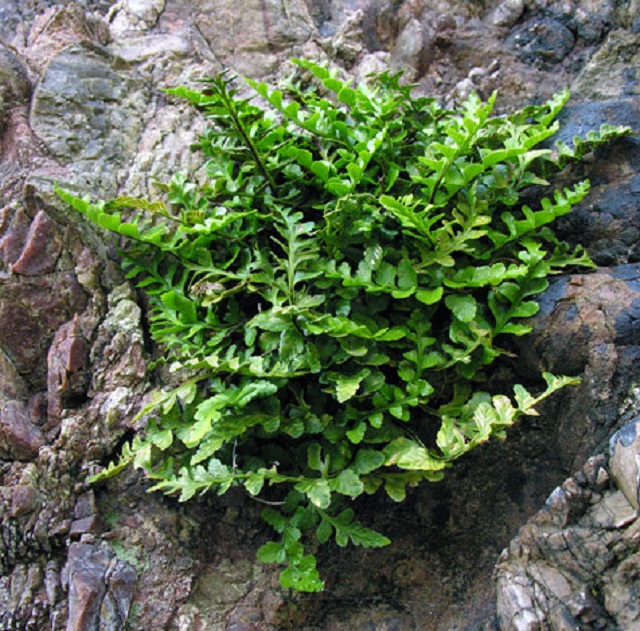
| Latin Name | Asplenium marinum |
| Best time to see | May to August. |
| Distribution | Sea spleenworts are mainly restricted to western coasts of the UK and are most common in Scotland and parts of Cornwall. |
| Habitat | Grows best in shaded crevices of rocky outcrops or sea cliffs, sometimes in range of sea spray. |
| Reproduction: | Reproduces by spores. |
| Uses | Aesthetic |
| Interesting fact | Sea spleenwort grows throughout the year and it requires a setting in coastal habitat to protect it from frost and snowfall, which it is very sensitive to. |
Buttercups
Meadow Buttercup
The meadow buttercup is one of the UK’s most familiar flowering plants, with bright yellow flowers that grow with five overlapping petals. The plant generally grows to 40 cm in height and has narrow, three-lobed leaves.
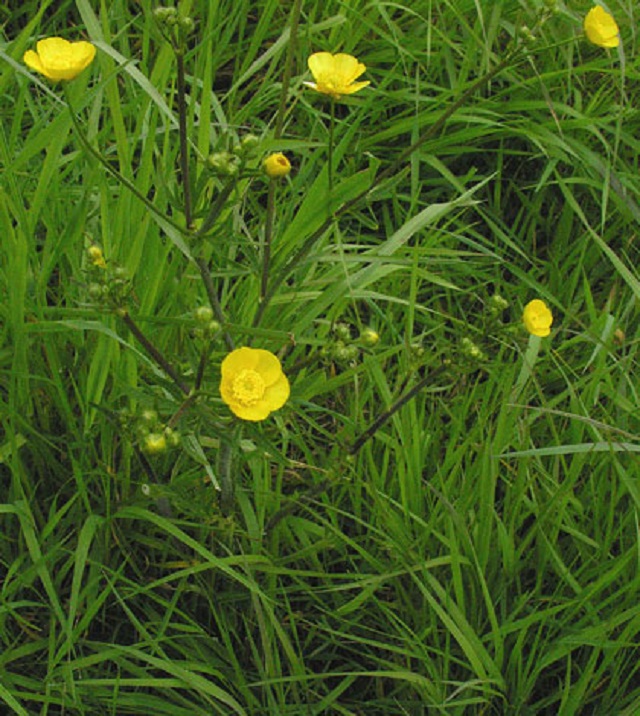
Photo Source: https://www.ukwildflowers.com/
| Latin Name | Ranunculus acris |
| Best time to see | May to August. |
| Distribution | Meadow buttercups can be found everywhere in the UK |
| Habitat | Grows especially well in well-drained soils such as chalk. It is common in grassland, on sea cliffs and in parks and gardens. |
| Reproduction: | Reproduces by seeds. Pollinated by insects. |
| Uses | Aesthetic |
| Interesting fact | Despite its beautiful appearance, the meadow buttercup is a poisonous plant and can cause abdominal pains if consumed. This is caused by toxic oils which are present in the leaves. |
Wood Anemone
Wood anemones are small, flowering plants that usually grow to about 20 cm tall. The leaves form a three-lobed rosette at the base of the plant and the flowers are white with yellow anthers and an occasional pink tinge.

Lilly M, CC BY-SA 3.0, via Wikimedia Commons
| Latin Name | Anemonoides nemorosa |
| Best time to see | March to May. |
| Distribution | Wood anemones are distributed very widely in the UK and can be seen almost everywhere. |
| Habitat | Shaded woodland is preferred, especially around ancient forest, although hedgerows and meadows are also good habitats. |
| Reproduction: | Reproduces by seeds. Pollinated by insects. |
| Uses | Aesthetic |
| Interesting fact | The Romans regarded wood anemones as lucky charms, with the first flowers to appear during the year thought to be capable of warding off fever if collected. Umbellifers |
Umbellifers
Alexanders
Alexanders is a tall, flowering plant that grows to a height of 1.5 m. It has a thick, branching stem with flat, toothed leaves and small flowers that are generally cream-coloured.
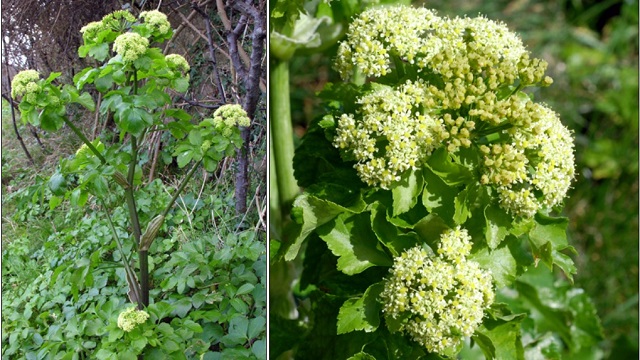
Photo Source: https://www.ukwildflowers.com/
| Latin Name | Smyrnium olusatrum |
| Best time to see | May to August. |
| Distribution | Alexanders is widely distributed in the UK, although tends to be coastal and is less common in the north of Scotland. |
| Habitat | Grows best on waste ground and at the edges of fields by the coast. Although mainly coastal, it also occurs inland on road verges and in woodland. |
| Reproduction: | Reproduces by seeds. Pollinated by insects. |
| Uses | Food |
| Interesting fact | The flowers of alexanders emit a very pungent smell late in the season. Despite this, all parts of the plant are edible, with the taste being compared to an intermediary of celery and parsley. |
Hemlock
Hemlock is a tall flowering plant which possesses a smooth, branching stem and triangular leaves. The flowers are small, white and grow in clusters, while the plant itself can reach 2.5 m in height.

Photo Source: https://www.ukwildflowers.com/
| Latin Name | Conium maculatum |
| Best time to see | May to August. |
| Distribution | Hemlock can be found in many parts of the UK, although doesn't occur at high altitude or in some parts of northern Scotland. |
| Habitat | Favours forest margins, as well as disturbed habitats and the edges of fields. |
| Reproduction: | Reproduces by seeds. Pollinated by insects. |
| Uses | Aesthetic |
| Interesting fact | Hemlock is extremely toxic to humans and other animals. In ancient Greece, the plant was often used as a poison, with the great philosopher Socrates thought to have died from consuming it. |
Sea Carrot
Sea carrots are herbaceous, flowering plants that grow to about 45 cm tall. They have clusters of small white flowers, triangular leaves and stems that are hairy in appearance.

Photo: Christian Fischer, CC BY-SA 3.0, via Wikimedia Commons
| Latin Name | Daucus carota |
| Best time to see | June to September. |
| Distribution | Sea carrots are common in many parts of the UK, especially near the coast. |
| Habitat | Grows well along roadsides, field edges and amongst hedgerows, both by the sea and further inland. |
| Reproduction: | Reproduces by seeds. Pollinated by insects. |
| Uses | Food |
| Interesting fact | In North America, the sea carrot is known as Queen Anne’s Lace. It gets this name from the resemblance of the flowers to lace clothing, which was often worn by Queen Anne of Great Britain in the 18th century. |
Sea Holly
Sea holly is an evergreen plant that is metallic blue in colour and has flattened, spiky leaves. It grows to about 50 cm tall and has cone-like flower heads that are blue or purple.
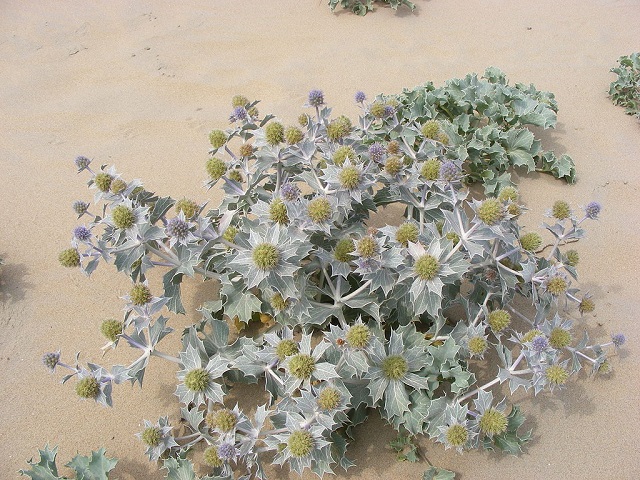
Teun Spaans, CC BY-SA 3.0, via Wikimedia Commons
| Latin Name | Eryngium maritimum |
| Best time to see | May to August. |
| Distribution | Sea holly grows on much of the UK coastline, being most common on western shores of Wales and Scotland. |
| Habitat | Can be seen on sandy soils and is most prevalent in areas of sand dune or shingle beach. |
| Reproduction: | Reproduces by seeds. Pollinated by insects. |
| Uses | Food, Medicine. |
| Interesting fact | Sea holly has many medicinal applications, including the alleviation of kidney stones and treatments of liver diseases. In centuries past, it was thought to be a strong aphrodisiac. |
Bindweeds
Common Sorrel
Common sorrel is a perennial plant characterised by having broad, arrow-shaped leaves. It grows to about 60 cm in height and has reddish-green flower spikes.
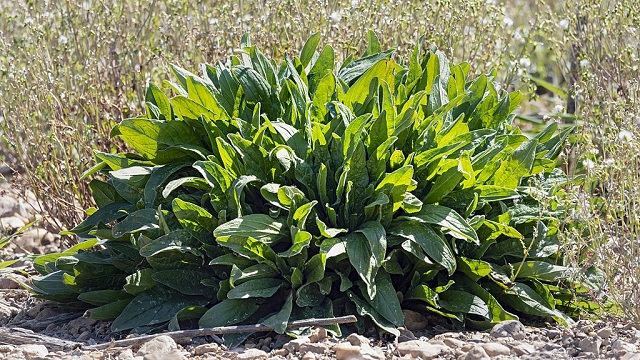
Muséum de Toulouse, CC BY-SA 4.0, via Wikimedia Commons
| Latin Name | Rumex acetosa |
| Best time to see | May to July. |
| Distribution | Common sorrel is a very abundant plant in the UK and grows almost everywhere. |
| Habitat | Mainly found in meadows and grassland habitats, as well as in verges and hedgerows. It grows especially well in partly-shaded areas.. |
| Reproduction: | Reproduces by seeds. Pollinated by insects. |
| Uses | Food |
| Interesting fact | The leaves of common sorrel have a tangy, citrus taste and have been cultivated as a food source for centuries. They are often used in salads, as well as to accompany fish dishes. |
Fiddle Dock
Fiddle dock grows with narrow, erect stems which can reach 70 cm in height. It has long, slender leaves which taper in the middle, and clusters of small, yellow flowers.
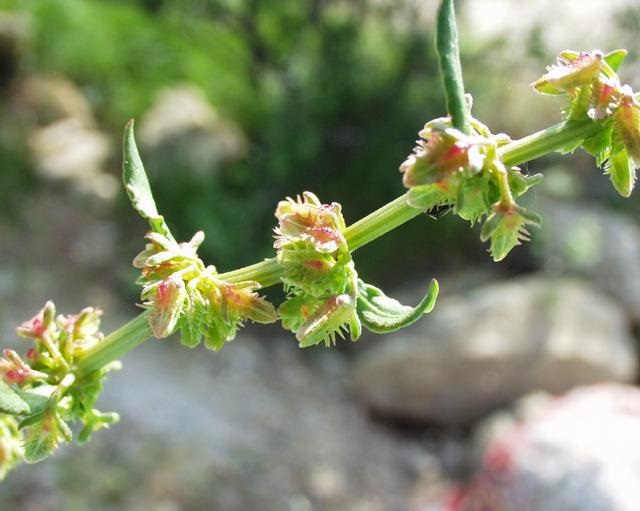
Photo: Henry Brisse (upload by user:Abalg), CC BY-SA 3.0, via Wikimedia Commons
| Latin Name | Rumex pulcher |
| Best time to see | June to July. |
| Distribution | Fiddle dock is mainly found in southern England, with small populations also occurring in Wales. |
| Habitat | Favours well-drained soil and often grows in coastal pastures and grasslands, as well as in churchyards and roadsides. |
| Reproduction: | Reproduces by seeds and rhizomes. Pollinated by insects. |
| Uses | Food |
| Interesting fact | The fiddle dock is so-called because the narrow leaves closely resemble the string instrument of the same name, as they taper in the centre and are rounded at each end. |
Ray’s Knotgrass
Ray’s knotgrass is a flowering plant with woody stems which creep along the ground and grow to lengths of 1 m. The leaves are narrow and bluish-green, while the flowers are white with five petals.
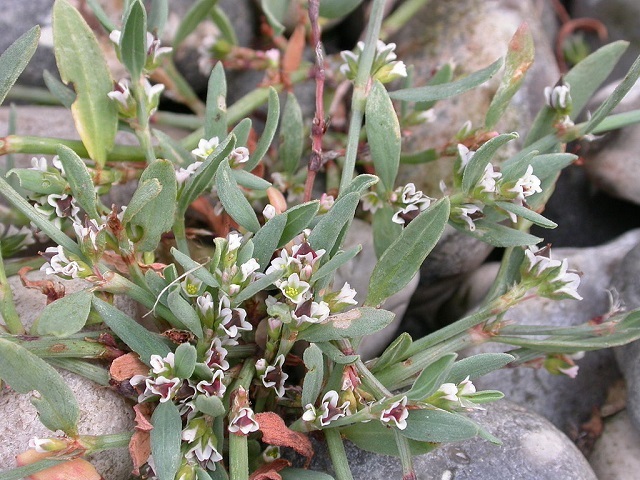
Photo: Olivier Pichard, CC BY-SA 3.0, via Wikimedia Commons
| Latin Name | Polygonum oxyspermum |
| Best time to see | June to September. |
| Distribution | Ray’s knotgrass is mainly found on western coasts of the UK, although small populations also exist in southern England and eastern Scotland. |
| Habitat | Seen most often on shingle beaches just above the tideline, though it also grows well on sandy substrates. |
| Reproduction: | Reproduces by seeds. Pollinated by insects. |
| Uses | Aesthetic |
| Interesting fact | The species name ‘oxyspermum’ means ‘sharp seed’, likely referring to the three-sided fruits that the plant produces during the summer months. |
Sheep’s Sorrel
Sheep’s sorrel is a slender plant with tall stems that grow to about 50 cm in height. The leaves are green and shaped like arrow-heads, while the flowers are reddish and grow on narrow flower spikes.
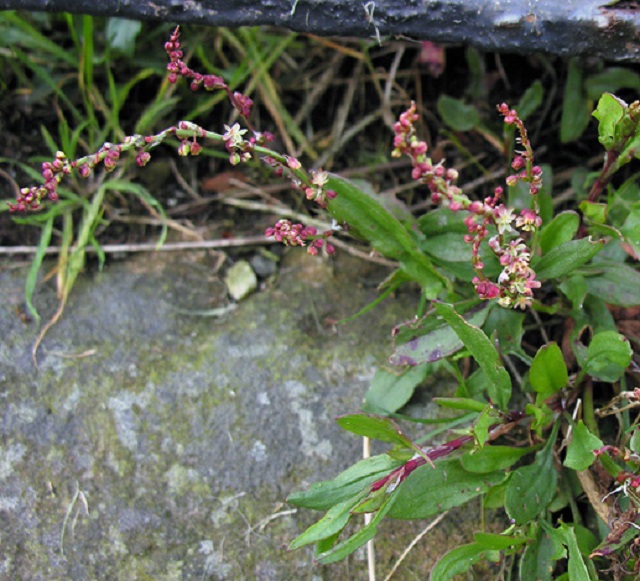
Photo Source: https://www.ukwildflowers.com/
| Latin Name | Rumex acetosella |
| Best time to see | May to August. |
| Distribution | Sheep’s sorrel is widespread in the UK, although is most commonly found on western coasts. |
| Habitat | Often seen growing on dry, sandy areas of grassland and heathland, although it often appears in disturbed areas such as abandoned mines. |
| Reproduction: | Reproduces by seeds and by producing rhizomes. |
| Uses | Food |
| Interesting fact | Sheep’s sorrel has a strong lemony taste, but contains high levels of oxalic acid, meaning it can easily damage the teeth of humans or grazing animals if consumed in large quantities. |
Shore Bindweed
Shore bindweed is a flowering vine that grows close to the ground, reaching up to 1 m in length. It has small, kidney-shaped leaves and attractive flowers which are generally large and light pink in colour.

Photo Source: https://www.ukwildflowers.com/
| Latin Name | Calystegia soldanella |
| Best time to see | May to August. |
| Distribution | Shore bindweeds can be found right around the UK coast, although they are most common in southern England and Wales. |
| Habitat | Grows best on sand dunes and shingle beaches, where it can be found above the high tide line. |
| Reproduction: | Reproduces by seeds. Pollinated by insects. |
| Uses | Aesthetic |
| Interesting fact | Shore bindweed is well-adapted to its coastal habitats, able to withstand being submerged in seawater for short periods. In fact, the sea often helps to disperse its seeds. |
Shore Dock
Shore docks have narrow, green leaves and grow vertically to heights of 70 cm. The flowers are reddish-brown and occur in whorls spread out up the stem.
 Photo Source: https://www.ukwildflowers.com/
Photo Source: https://www.ukwildflowers.com/
| Latin Name | Rumex rupestris |
| Best time to see | June to August. |
| Distribution | The shore dock is mainly restricted to south-west England and Wales, occurring in just a few localities. |
| Habitat | Primarily a coastal species, it prefers sandy soils adjacent to constant freshwater sources such as streams. It also grows at the base of sea-cliffs. |
| Reproduction: | Reproduces by seeds and by rhizomes. Pollinated by insects. |
| Uses | Aesthetic |
| Interesting fact | The shore dock is struggling in the UK, with rising sea levels and habitat loss from human beach activities threatening its current populations. |
Common Honeysuckle
The common honeysuckle is a flowering climber which boasts tubular, yellowish-white flowers. It has dark green, oval leaves and can grow to 7 m in height.
 Photo Source: https://www.ukwildflowers.com/
Photo Source: https://www.ukwildflowers.com/
| Latin Name | Lonicera periclymenum |
| Best time to see | July to September. |
| Distribution | Common honeysuckle can be found throughout the UK. |
| Habitat | Often grows in woodland, scrubby habitats and hedgerows, but also does well in coastal areas. |
| Reproduction: | Reproduces by seeds. Pollinated by insects. |
| Uses | Aesthetic |
| Interesting fact | The flowers of common honeysuckle have a very sweet scent that grows stronger during the night. This helps to attract moths, which sip on the nectar of the flowers and help to pollinate them. |
Common Ivy
Common ivy is an evergreen, flowering plant that produces dome-shaped clusters of small, yellow flowers. It is a climbing species, reaching heights of 30 m in some cases, and has three-lobed leaves.

Photo: KENPEI, CC BY-SA 3.0, via Wikimedia Commons
| Latin Name | Hedera helix |
| Best time to see | September to November. |
| Distribution | Common ivy is prevalent throughout much of the UK and can be found almost everywhere. |
| Habitat | Prefers shaded woodland, but can grow in a variety of habitats such as wasteland and gardens, where it often clings to tree trunks or walls. |
| Reproduction: | Reproduces by seeds. Pollinated by insects. |
| Uses | Aesthetic |
| Interesting fact | It was once thought that wrapping a wreath of ivy around the head could prevent someone from becoming drunk. The Roman god Bacchus – god of intoxication – was often shown wearing ivy wreaths for this reason. |
Gentians
Autumn Gentian
Autumn gentians are upright, flowering plants which grow to heights of around 30 cm. They have small, elliptical leaves and purple flowers which are bell-shaped, with five petals.

Photo Source: https://www.ukwildflowers.com/
| Latin Name | Gentianella amarella |
| Best time to see | July to September. |
| Distribution | Autumn gentians have a patchy distribution in the UK, with the largest populations in southern and central England, as well as northern Scotland. |
| Habitat | Favours well-drained soils such as those in chalk or limestone grasslands. Also lives amongst sand dunes and machair. |
| Reproduction: | Reproduces by seeds. Pollinated by insects. |
| Uses | Medicine |
| Interesting fact | The root of the autumn gentian is highly medicinal and can be used to treat digestive disorders, as well as being a strong anti-inflammatory. |
Squinancywort
Squinancywort is a small, low-growing herb which grows from a woody rootstock. It reaches a height of about 25 cm and can be identified by its tiny, white flowers which have four petals. The leaves are very narrow.
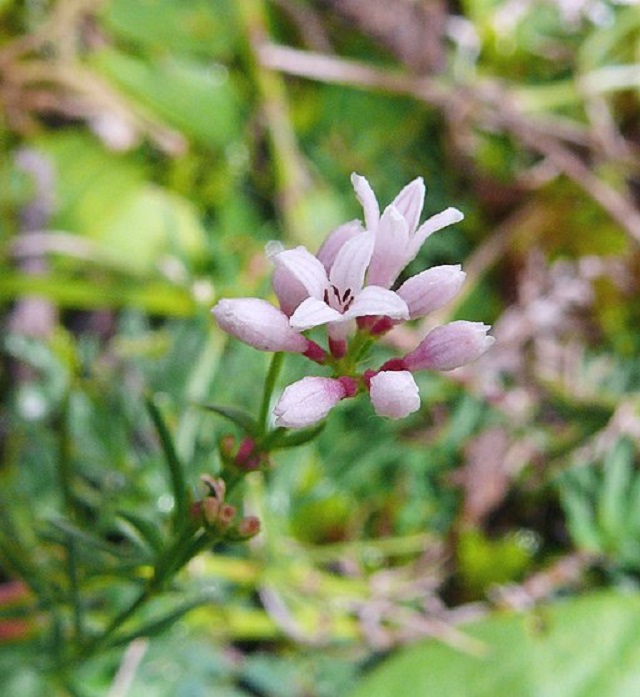
Bernd Haynold, CC BY-SA 3.0, via Wikimedia Commons
| Latin Name | Asperula cynanchica |
| Best time to see | June to July. |
| Distribution | Squinancywort is largely confined to southern England and Wales. |
| Habitat | Specialises in growing on chalk grassland, primarily in coastal areas but also further inland. |
| Reproduction: | Reproduces by seeds and by rhizomes. Pollinated by insects. |
| Uses | Medicine, Dye. |
| Interesting fact | Squinancywort gets its unusual name from its former use as a medicinal herb to cure quinsy – a painful condition of the tonsils and throat. |
Wild Madder
Wild madder is a trailing flowering plant with clusters of small, star-like yellow flowers. It produces black berries in winter and has narrow, leathery leaves. It grows to about 30 cm tall.
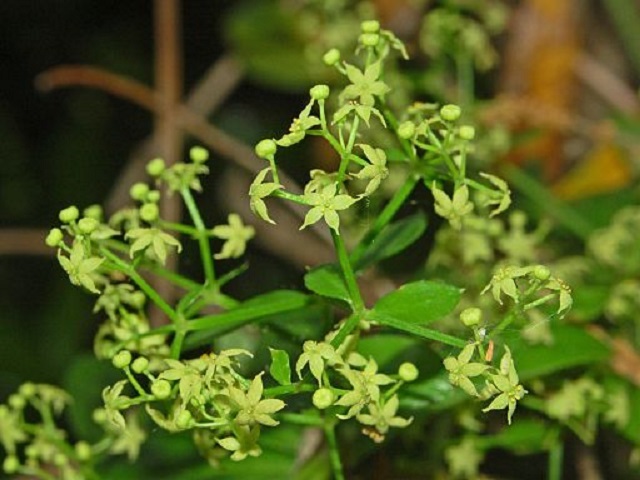
Hectonichus, CC BY-SA 3.0, via Wikimedia Commons
| Latin Name | Rubia peregrina |
| Best time to see | April to June. |
| Distribution | Wild madder is most commonly seen growing in south-west England and the coasts of Wales. |
| Habitat | Often found in rocky scrub or along sea-cliff paths, but does well in woodland habitats and in hedgerows. |
| Reproduction: | Reproduces by seeds and by rhizomes. Pollinated by insects. |
| Uses | Medicine, Dye. |
| Interesting fact | Wild madder is closely related to coffee plants, although it is most often used for the purposes of dyeing cloth, as the roots produce a bright pink pigment. |
Leadworts
Sea Lavender
Sea lavenders are perennial flowering plants which grow upright, to heights of around 30 cm. They have blunt, spoon-shaped flowers and clusters of small, light purple flowers with five petals.
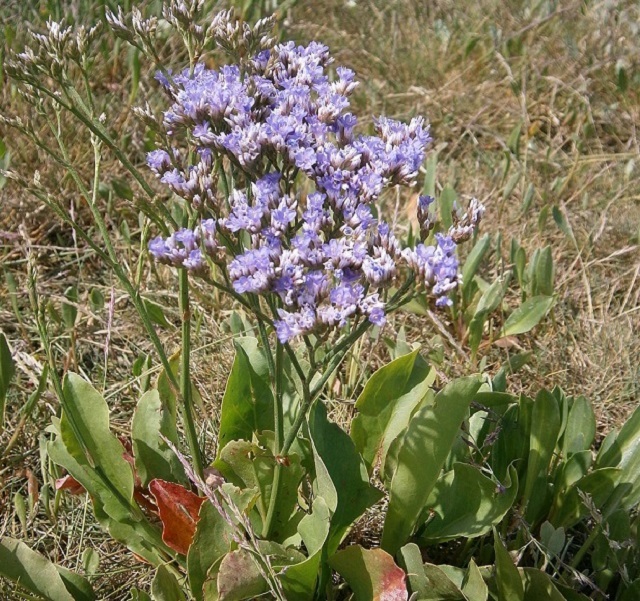
Meneerke bloem, CC BY-SA 3.0, via Wikimedia Commons
| Latin Name | Limonium vulgare |
| Best time to see | July to September. |
| Distribution | Sea lavender is mainly distributed around the coastlines of England and Wales, though some can be found in southern Scotland. |
| Habitat | Often seen in low-lying marshes and around estuaries, as well as other coastal habitats such as damp dunes. |
| Reproduction: | Reproduces by seeds. Pollinated by insects. |
| Uses | Aesthetic |
| Interesting fact | The genus name of the sea lavender, Limonium, translates as ‘of a moist meadow’. This is a reference to the fact that the species in the genus favour wet, open areas of land. |
Sea Thrift
Sea thrift is a small flowering plant that grows in dense clumps. The leaves are flattened and linear, while its globular pink flower heads grow at the tops of stalks that average 15 cm in height.
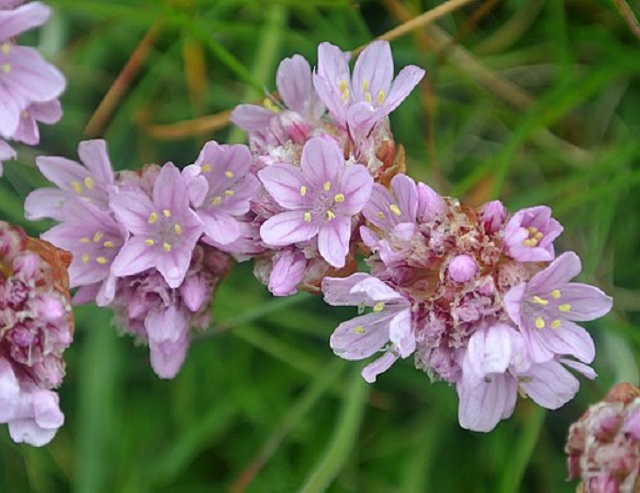
Wilson44691, CC0, via Wikimedia Commons
| Latin Name | Armeria maritima |
| Best time to see | May to July. |
| Distribution | Sea thrift is widespread along the UK’s coastlines, but is especially common in north-western Scotland and Wales. |
| Habitat | Prefers to grow on wild coastal areas such as sea-cliffs, although also does well on shingle beaches and saltmarshes. |
| Reproduction: | Reproduces by seeds. Pollinated by insects. |
| Uses | Aesthetic |
| Interesting fact | Sea thrift is a very popular plant amongst gardeners and can often be seen growing in rock gardens. This popularity led to it being featured on threepenny-bit coins between 1937 and 1953. |
Roses
Dog Rose
The dog rose is a flowering, climbing plant known for having bright pink flowers, although they can also be white. It has pinnate leaves and prickles all over the stem, and grows to heights of up to 5 m.
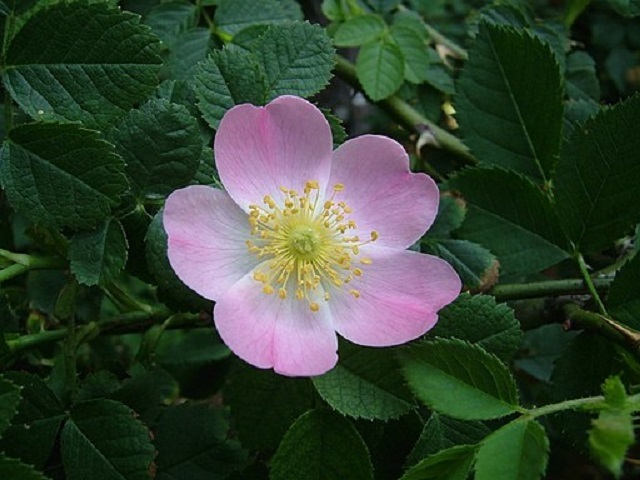
Photo: Sakurai Midori, CC BY-SA 2.1 JP, via Wikimedia Commons
| Latin Name | Rosa canina |
| Best time to see | June to July. |
| Distribution | The dog rose is common throughout most of the UK, although is less prevalent in northern Scotland and Northern Ireland. |
| Habitat | Grows in a range of habitats, but particularly on the sunny side of hedgerows and on woodland edges. |
| Reproduction: | Reproduces by seeds. Pollinated by insects. |
| Uses | Medicine, Food, Skincare. |
| Interesting fact | Dog roses produce red fruits known as rose hips. These are widely used to make rosehip syrup, which has 20 times higher vitamin C levels than orange juice. |
Rock Rose
The rock rose is an evergreen, flowering plant which grows to heights of around 1 m. It has yellow, saucer-shaped flowers and narrow leaves that grow in pairs.
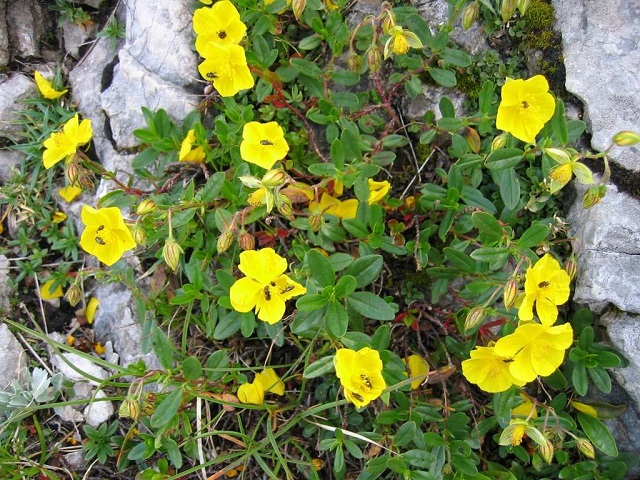
Photo: Tigerente, CC BY-SA 3.0, via Wikimedia Commons
| Latin Name | Helianthemum nummularium |
| Best time to see | May to July. |
| Distribution | Rock roses can be found in large parts of southern England and Wales, as well as eastern Scotland. They are generally absent from north-west Scotland. |
| Habitat | Prefers sunny places in habitats such as chalk downs and coastal grassland. It also does well in short meadows. |
| Reproduction: | Reproduces by seeds. Pollinated by insects. |
| Uses | Aesthetic |
| Interesting fact | The rock rose is also known as ‘the flower of the sun’. This in part due to its yellow flowers, but also because of its preference for sunny growing areas. |
Silverweed
Silverweed is a flowering plant that is well-known for having long, saw-toothed leaves covered in silver hairs. It grows to around 60 cm high on average and has singular yellow flowers.
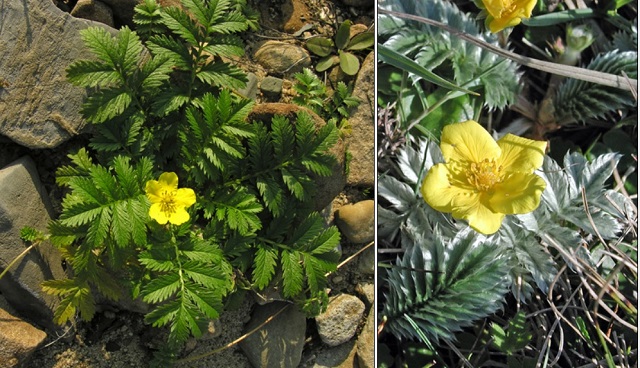 Photo Source: https://www.ukwildflowers.com/
Photo Source: https://www.ukwildflowers.com/
| Latin Name | Argentina anserina |
| Best time to see | June to August. |
| Distribution | Silverweed is very common in the UK and can be found growing almost everywhere, apart from at high altitude. |
| Habitat | Grows in a range of habitats, although favours sandy or gravelly soils such as in sand dunes or on roadsides. |
| Reproduction: | Reproduces by seeds and by stolons. Pollinated by insects. |
| Uses | Food |
| Interesting fact | Silverweeds grow roots that are similar in appearance to parsnips. The roots can be eaten both raw and cooked, and were often used as a food source by Native American tribes. |
Cabbages
Danish Scurvy-grass
A short plant, Danish scurvy-grass is a flowering annual that grows to about 20 cm tall. It has small, heart-shaped leaves and clustered flowers that are usually white or lilac in colour.

User:Strobilomyces, CC BY-SA 3.0, via Wikimedia Commons
| Latin Name | Cochlearia danica |
| Best time to see | May to July. |
| Distribution | Danish scurvy-grass is common in the UK but mainly grows in lowland areas. As such, it cannot be found in much of north-west Scotland. |
| Habitat | Prefers to grow on sea-cliffs, sand dunes and on sea walls. It also does well inland, where it can be found along roadsides. |
| Reproduction: | Reproduces by seeds. Pollinated by insects. |
| Uses | Foos |
| Interesting fact | Danish scurvy-grass gets its name from sailors, who would chew on the leaves to avoid scurvy. The plant is full of vitamin C, although tends to have a very pungent flavour. |
Sea Kale
Sea kale is a flowering plant with large fleshy, bluish-green leaves. It grows in large clumps, to heights of about 75 cm, and produces many white flowers.
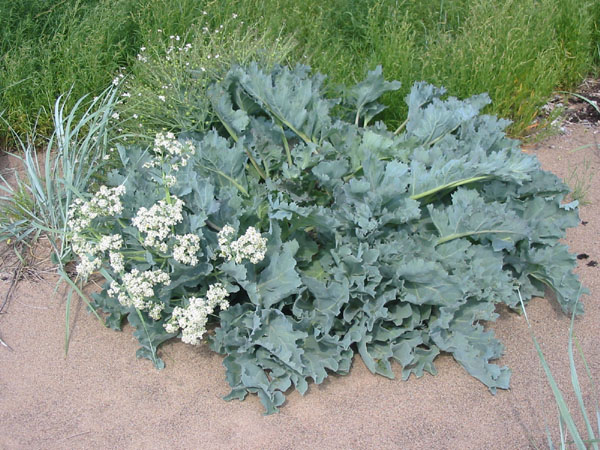
Siim at et.wikipedia, CC BY-SA 2.5, via Wikimedia Commons
| Latin Name | Crambe maritima |
| Best time to see | May to July. |
| Distribution | Sea kale is distributed along the coasts of southern and eastern England, Wales and eastern Scotland. |
| Habitat | Grows on shingle and rocky beaches above the high-tide mark, although can also be found amongst sand dunes. |
| Reproduction: | Reproduces by seeds and by root. Pollinated by insects. |
| Uses | Food |
| Interesting fact | Sea kale is very closely related to the cabbage and has been cultivated in Britain from as early as the 18th century. The leaves are said to have a pleasant, almost nutty flavour. |
Geraniums
Bloody Crane’s-Bill
Bloody crane’s-bill is a perennial flowering plant that can be identified by its rounded, purple flowers. It has branched, hairy stems and grows to heights of up to 50 cm, with leaves that are divided into many lobes.
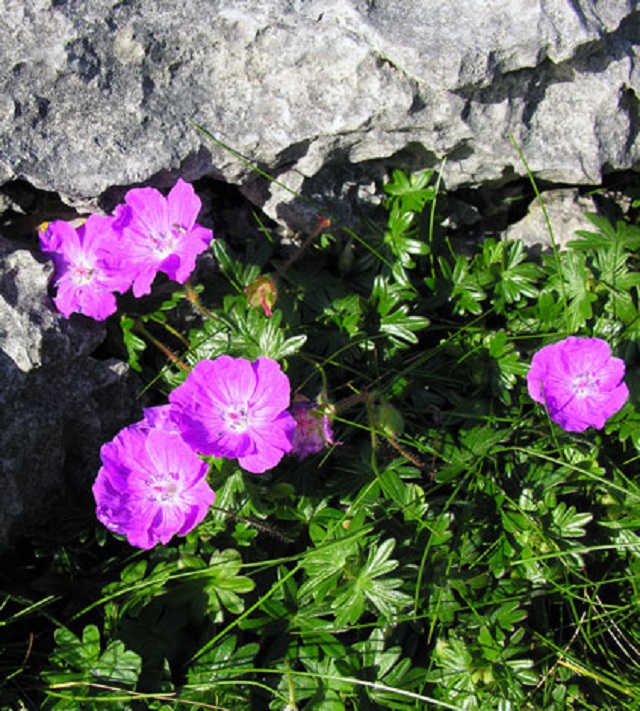
Photo Source: https://www.ukwildflowers.com/
| Latin Name | Geranium sanguineum |
| Best time to see | June to August. |
| Distribution | Bloody crane’s-bill occurs across much of the UK, although is very patchy in its distribution. It is less common in north-west Scotland and Northern Ireland. |
| Habitat | Grows well in coastal sand dunes and regions of chalk grassland. Further inland, it prefers limestone habitats. |
| Reproduction: | Reproduces by seeds and by rhizomes. Pollinated by insects. |
| Uses | Aesthetic |
| Interesting fact | The name of the bloody crane’s-bill stems from its appearance. It produces long, beak-like fruits, from which is gets the ‘crane’s-bill’ part of its name. And its association with blood comes from the leaves, which turn bright red in Autumn. |
Daisies
Blue Fleabane
Blue fleabane relies on the wind to disperse its seeds. Each one possesses a ‘pappus’ – a silky parasail which helps the seed to drift through the air and be carried long distances.

Photo: Kurt Stüber [1], CC BY-SA 3.0, via Wikimedia Commons
| Latin Name | Erigeron acer |
| Best time to see | June to August. |
| Distribution | Blue fleabane can mainly be found in southern and central England, with small populations in Wales and southern Scotland. coast. |
| Habitat | Favours open, well-drained habitats such as sand dunes, rocky outcrops and wasteland, both on the coast and inland. |
| Reproduction: | Reproduces by seeds and by rhizomes. Pollinated by insects. |
| Uses | Aesthetic |
| Interesting fact | Blue fleabane relies on the wind to disperse its seeds. Each one possesses a ‘pappus’ – a silky parasail which helps the seed to drift through the air and be carried long distances. |
Golden Samphire
Golden samphire is a perennial flowering plant which grows in large tufts, to heights of up to 1 m. It has narrow, fleshy leaves and large flower heads that are bright yellow in colour.
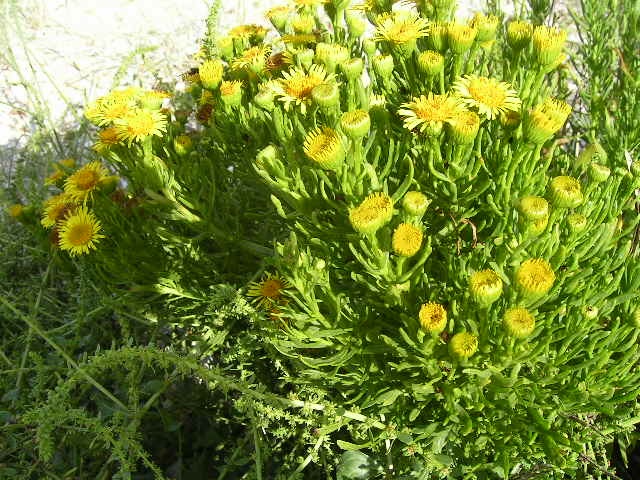
Photo: chilepine, Public domain, via Wikimedia Commons
| Latin Name | Limbarda crithmoides |
| Best time to see | July to October. |
| Distribution | Golden samphire grows in southern parts of the UK, mainly on the south coasts of England and Wales. |
| Habitat | Coastal habitats such as sea-cliffs and shingle beach are preferred, although it also grows well in areas of saltmarsh. |
| Reproduction: | Reproduces by seeds and by rhizomes. Pollinated by insects. |
| Uses | Food |
| Interesting fact | The flowers of golden samphire are said to smell somewhat like shoe polish. They are very attractive to insects such as bees and beetles. |
Greater Knapweed
An upright perennial, greater knapweed grows to heights of 75 cm. The stems are topped by large, purple flower heads, while the leaves are pinnately lobed and slightly leathery.

Photo Source: https://www.ukwildflowers.com/
| Latin Name | Centaurea scabiosa |
| Best time to see | July to October. |
| Distribution | Greater knapweed is widespread in much of England and Wales, with small populations in south-east Scotland. |
| Habitat | Found in a variety of habitats including wasteland, roadsides and woodland edges. Grows especially well in coastal grassland. . |
| Reproduction: | The flowers are pollinated by insects, which then produce seeds. |
| Uses | Medicine |
| Interesting fact | The Latin name ‘scabiosa’ stems from the fact that greater knapweeds were widely used in past centuries to treat scabies – a painful skin infection caused by mites. |
Sea Aster
The sea aster is a brightly coloured flowering plant, with vibrant purple flowers that have thin petals and yellow centres. It has fleshy, lanceolate leaves and grows to around 50 cm tall.
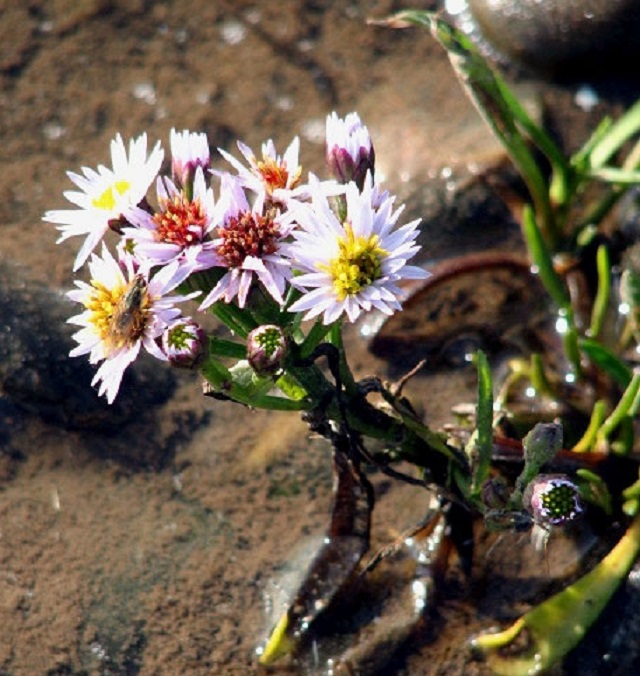
Evelyn Simak / Sea aster (Aster tripolium)
| Latin Name | Tripolium pannonicum |
| Best time to see | July to September. |
| Distribution | Sea aster is distributed right around the UK coastline, especially in western regions. |
| Habitat | Primarily lives in alkaline habitats by the coast, including saltmarshes and estuaries. It also grows on sea-cliffs. |
| Reproduction: | Reproduces by seeds. Pollinated by insects. |
| Uses | Aesthetic |
| Interesting fact | The sea aster is normally a late-flowering species and is an important source of nectar for insects such as late butterflies. In parts of Dorset and Somerset, it is often referred to as ‘summer’s farewell’. |
Sea Mayweed
Sea mayweeds are short-lived perennials known for their white, daisy-like flowers. They grow with erect stems to heights of 60 cm, and have very small, fleshy leaves.
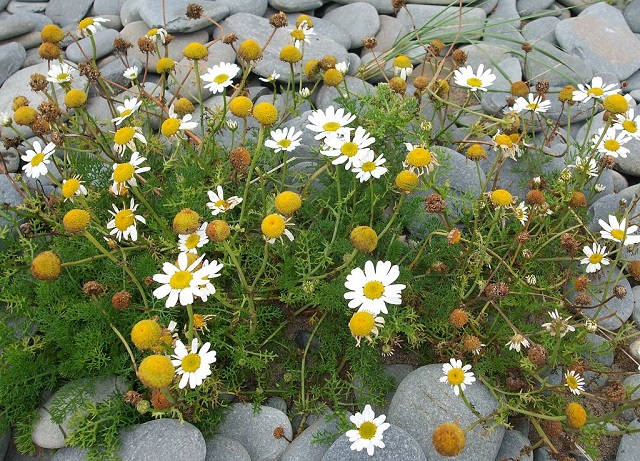
Photo: User:Jamesnbryant, CC BY-SA 3.0, via Wikimedia Commons
| Latin Name | Tripleurospermum maritimum |
| Best time to see | July to September. |
| Distribution | Sea mayweed is very common and can be found right around the UK coastline. |
| Habitat | As a coastal specialist, it can be found growing on beaches, sand dunes and sea-cliffs. It can also grow among rock crevices and on walls. |
| Reproduction: | Reproduces by seeds. Pollinated by insects. |
| Uses | Aesthetic |
| Interesting fact | Sea mayweed is a halophyte, meaning it is a salt-tolerant plant that can survive in extreme salty environments that would kill many other types of plant. |
Slender Thistle
Slender thistles are tall flowering plants which can reach 2 m in height. They have long spines on their stems and olive-green leaves, which are lobed and wrinkled. The flower heads are large and purple.

Photo source: https://www.ukwildflowers.com/
| Latin Name | Carduus tenuiflorus |
| Best time to see | June to August. |
| Distribution | Slender thistles are found on much of the UK coast, but are most common in southern England and are absent from north-west Scotland. |
| Habitat | Dry, coastal grasslands are preferred, along with dune fringes and sandy wasteground. |
| Reproduction: | Reproduces by seeds. Pollinated by insects. |
| Uses | Aesthetic |
| Interesting fact | The slender thistle is also known as the ‘winged thistle’, due to the leaf-like wings which grow from the stem. These wings taper to sharp spines. |
Sheep’s Bit
Sheep’s bit is a flowering plant that has narrow, lanceolate leaves and violet flowers that grow in small heads. The slender stems are hairy and grow to 40 cm.
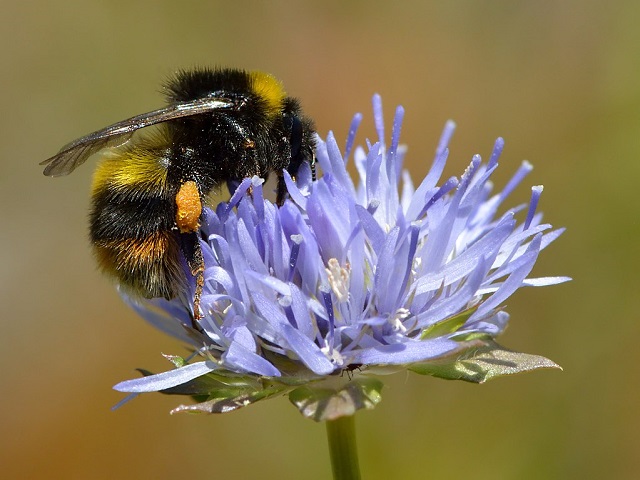
Photo: Ivar Leidus, CC BY-SA 4.0, via Wikimedia Commons
| Latin Name | Jasione montana |
| Best time to see | June to September. |
| Distribution | Sheep’s bit is largely confined to south-western areas of the UK, especially in Wales. It also grows in western Scotland and around the Northern Isles. |
| Habitat | Can be found in coastal grassland and heath, especially on acidic soils. Further inland, it does well in hedgerows and stone walls. |
| Reproduction: | Reproduces by seeds. Pollinated by insects. |
| Uses | Aesthetic |
| Interesting fact | The flowers of sheep’s bit show up well under UV light. It is thought that this characteristic makes them far more attractive to the insects that pollinate them. |
Plantains
Common Foxglove
Common foxgloves are tall, flowering plants which grow to heights of 2 m. The leaves are broad and covered in silver hairs, while the tubular flowers are purple and grow right up the stem.
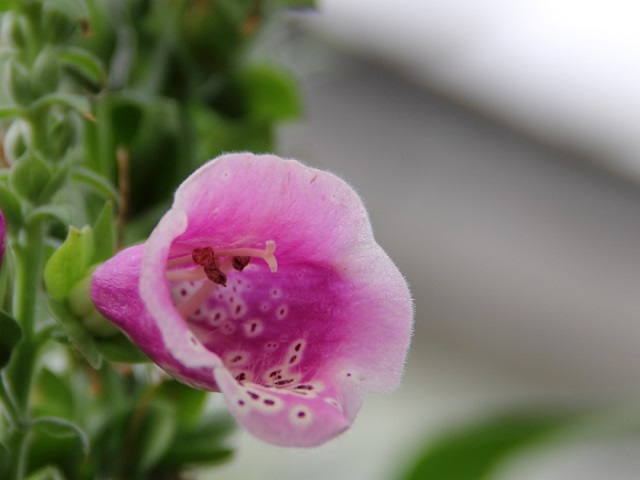
Photo: Fan Wen, CC BY-SA 4.0, via Wikimedia Commons
| Latin Name | Digitalis purpurea |
| Best time to see | June to September. |
| Distribution | Common foxgloves are very widespread in the UK and can be found almost everywhere. |
| Habitat | Can be seen on acidic soils, especially in hedgerows, woodland and wasteland. Also grows well along sea-cliffs. |
| Reproduction: | Reproduces by seeds. Pollinated by insects. |
| Uses | Medicine (although is poisonous if consumed directly). |
| Interesting fact | The name of the common foxglove is derived from the historic belief that foxes would pull the flowers over their paws to help quieten their footsteps when hunting. |
Heath Speedwell
Heath speedwell is a perennial flowering plant with hairy green stems, which grow to 30 cm long on average. The leaves are broad, while the flowers are small, violet and grow on short vertical shoots.
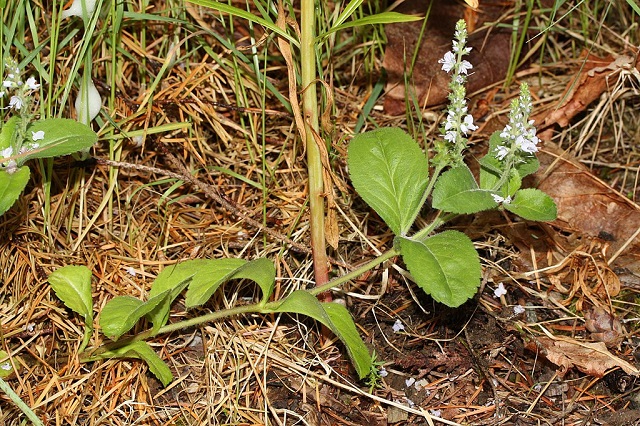
Walter Siegmund, CC BY-SA 3.0, via Wikimedia Commons
| Latin Name | Veronica officinalis |
| Best time to see | May to August. |
| Distribution | Heath speedwells are widespread in the UK and can be found almost everywhere. |
| Habitat | Grows well on dry, acidic soils in habitats such as woodland, heathland and short grassland. Can also be found in gardens. |
| Reproduction: | Reproduces by seeds. Pollinated by insects. |
| Uses | Food, Medicine. |
| Interesting fact | The leaves of heath speedwell have a tangy taste and can be dried and added to tea blends. It is sometimes referred to as ‘Europe tea’ for this reason. |
Ivy-leaved Toadflax
Ivy-leaved toadflax is a trailing plant named for its small, ivy-shaped leaves. It is low-growing – but can spread to 50 cm in diameter – and has distinctive spurred flowers that are light purple in colour.
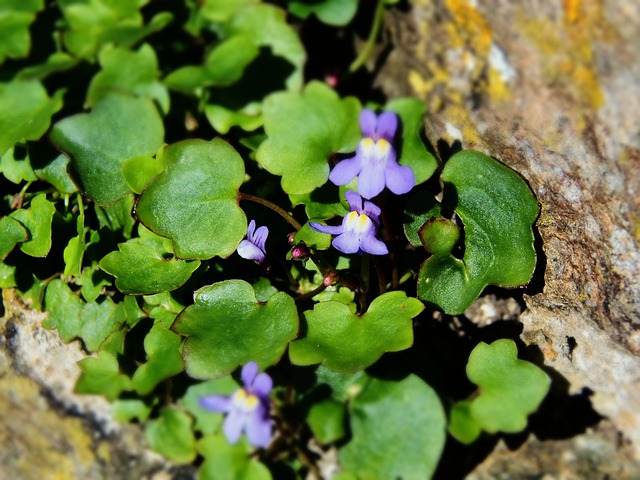
Photo: u_3heuehh9 vis Pixabay
| Latin Name | Cymbalaria muralis |
| Best time to see | June to September. |
| Distribution | Ivy-leaved toadflax is common throughout much of the UK, with the exception of north-west Scotland. |
| Habitat | Prefers to grow on old walls and bridges, but will also trail along tree trunks or grow amongst shingle beaches. |
| Reproduction: | The flowers are pollinated by insects, which then produce seeds. |
| Uses | Food |
| Interesting fact | Ivy-leaved toadflax has an unusual method of propagation. Once the flowers have been fertilised, the flower heads grow away from the light, so that the seeds are more likely to be shed into cracks. |
Legumes
Bird’s-foot Trefoil
Bird’s-foot trefoil is a flowering plant with bright yellow clusters of pea flowers. The leaves have five leaflets and are slightly downy, while the stems grow to about 30 cm in height.
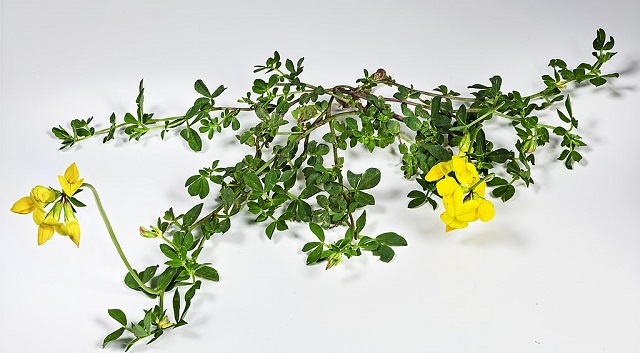
Muséum de Toulouse, CC BY-SA 4.0, via Wikimedia Commons
| Latin Name | Lotus corniculatus |
| Best time to see | May to September. |
| Distribution | Bird’s-foot trefoil is very common in the UK and is distributed widely. |
| Habitat | Can be found on grasslands, well-drained meadows and chalk downs. It grows very well in coastal habitats such as shingle beaches and sea-cliffs. |
| Reproduction: | Reproduces by seeds and by rhizomes. Pollinated by insects. |
| Uses | Hay |
| Interesting fact | The seed pods together with the stalks of this species look very similar to bird’s feet, hence the name. The flowers are a very important source of nectar for insects such as bees and butterflies. |
Common Gorse
Common gorse is a large, evergreen shrub that can grow to 3 m in height. The leaves are modified into long spines and the flowers are coloured a vibrant yellow, and are pea-like.
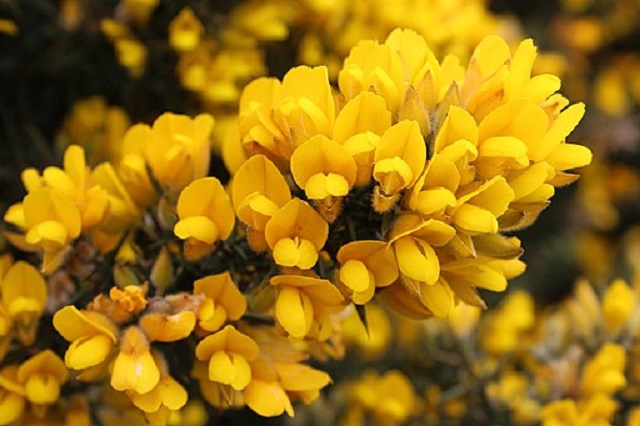
PaleCloudedWhite, CC BY-SA 4.0, via Wikimedia Commons
| Latin Name | Ulex europaeus |
| Best time to see | April to May. |
| Distribution | Common gorse can be found right across the UK. |
| Habitat | Grows in a variety of habitats, including woodland, grassland and heath. It prefers coastal areas. |
| Reproduction: | Reproduces by seeds and by root. Pollinated by insects. |
| Uses | Food |
| Interesting fact | In old British folklore, it is said that you should not kiss your loved ones when common gorse is not in bloom. As it flowers from January until June, the window for this is therefore longer than for most other flowering species. |
Horseshoe Vetch
Horseshoe vetch is a perennial flowering plant with bright yellow flowers, which grow on stalked heads. The leaves are pinnate with many oval leaflets and the plant grows to 20 cm tall on average.
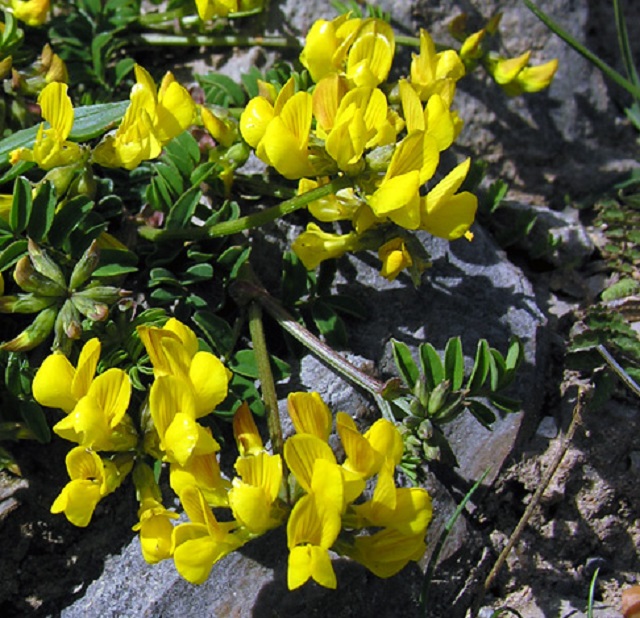
Photo Source: https://www.ukwildflowers.com/
| Latin Name | Hippocrepis comosa |
| Best time to see | May to June. |
| Distribution | Horseshoe vetch is most common in southern England, with small populations in the Midlands. |
| Habitat | Favours sunny pastures on chalk and limestone sea-cliffs, but also grows well on roadsides. |
| Reproduction: | Reproduces by seeds and by root. Pollinated by insects. |
| Uses | Aesthetic |
| Interesting fact | Horseshoe vetch is the sole foodplant for caterpillars of the chalkhill blue and the adonis blue butterfly. As such, it is very important for the survival of these species. Kidney Vetch |
Kidney Vetch
A perennial flowering plant, kidney vetch is known for its spherical flower heads which boast numerous yellow flowers. It has pinnate leaves with scattered hairs, and grows to 40 cm tall.
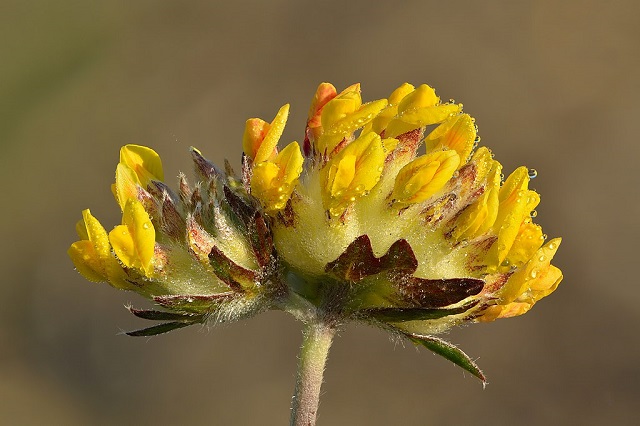
Ivar Leidus, CC BY-SA 4.0, via Wikimedia Commons
| Latin Name | Anthyllis vulneraria |
| Best time to see | June to September. |
| Distribution | Kidney vetch can be found in most parts of the UK but is especially common around the coast. |
| Habitat | Dry grassland on calcareous soil is preferred, although it can also be seen on rocky outcrops near to the sea. |
| Reproduction: | Reproduces by seeds and by root. Pollinated by insects. |
| Uses | Food, Medicine. |
| Interesting fact | The species name of kidney vetch – vulneraria – translates as ‘wound healer’ in reference to the plant being commonly used as a remedy for skin ruptures. |
Vervains
Common Vervain
Common vervain is a perennial flowering plant which grows with thin, upright stems to heights of 70 cm. It has short spikes with purplish-pink flowers and flat, toothed leaves.

Photo Source: https://www.ukwildflowers.com/
| Latin Name | Verbena officinalis |
| Best time to see | July to September |
| Distribution | Common vervain is mainly distributed across southern England and Wales, although some may be found scattered through northern England. |
| Habitat | Favours open ground and bare habitats, so is often seen in scrubland, roadsides and rough grassland. It also does well on sea-cliffs. |
| Reproduction: | Reproduces by seeds. Pollinated by insects. |
| Uses | Food, Medicine. |
| Interesting fact | Common vervain has a range of medicinal properties, and has been used widely for centuries as a treatment for headaches, fevers and minor injuries. It should not, however, be given to pregnant women. |
Pond Weeds
Fennel Pondweed
Fennel pondweed is an aquatic plant with long, tubular leaves that grow in a zig-zag pattern. The leaves are leathery and it grows green, insignificant flowers on short spikes.
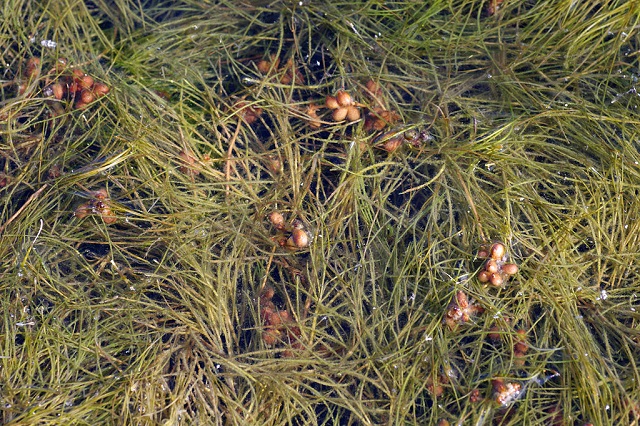
Christian Fischer, CC BY-SA 3.0, via Wikimedia Commons
| Latin Name | Potamogeton pectinatus |
| Best time to see | May to September. |
| Distribution | Fennel pondweed is widely found in the UK, although is less common in Wales and Scotland. It is widespread in the Hebrides, however. |
| Habitat | A freshwater plant, it can be seen in brackish waters of ponds, lakes and canals. It can also be found in ditches and flooded areas. |
| Reproduction: | Reproduces by seeds and by tubers. Pollinated by water. |
| Uses | Food |
| Interesting fact | Fennel pondweed can be a problem plant in some areas as it grows rapidly and cane tolerate very low oxygen levels, allowing it to colonise areas habitats other species struggle to grow in. |
Seagrasses
Common Eelgrass
Common eelgrass is a flowering marine plant that produces long stems with hair-like leaves. The flowers are green and insignificant, but the plant itself can reach over 1 m in length.
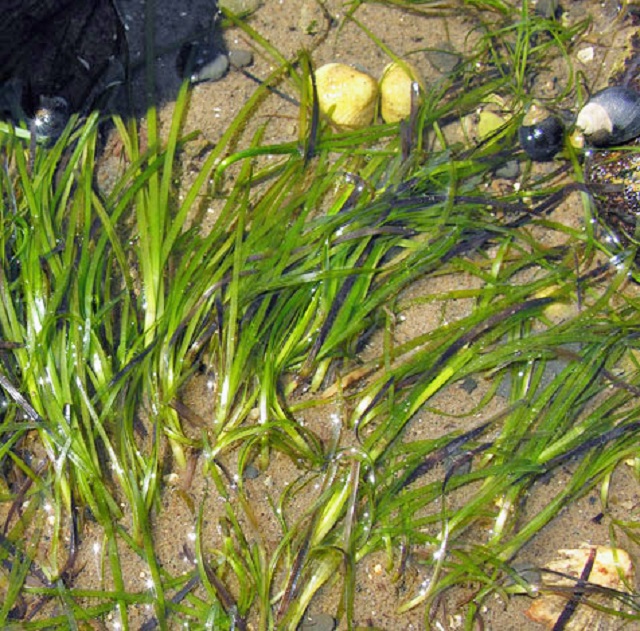
Photo Source: https://www.ukwildflowers.com/
| Latin Name | Zostera marina |
| Best time to see | May to September. |
| Distribution | Common eelgrass can be found right around the UK coast, although is more common on western shores. |
| Habitat | Grows in the intertidal zone to depths of around 4 m. It is often seen on sandy or muddy substrates in sheltered areas. |
| Reproduction: | Reproduces by seeds and by rhizomes. Pollinated by water. |
| Uses | Food, Roof thatching. |
| Interesting fact | Common eelgrass is a highly important species in marine ecosystems. It provides a sheltered habitat for many creatures, especially young fish and invertebrates. |
Dwarf Eelgrass
Dwarf eelgrass is a marine flowering plant with long, ribbon-shaped leaves that are very similar to those of terrestrial grasses. It reaches about 20 cm in length and has small, green flowers which grow on spikes.
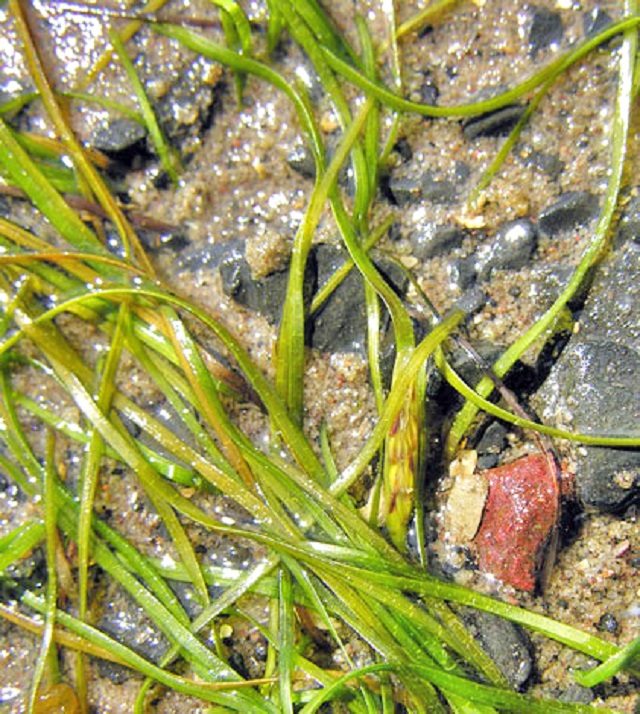
Photo Source: https://www.ukwildflowers.com/
| Latin Name | Zostera noltei |
| Best time to see | June to August. |
| Distribution | Dwarf eelgrass is patchily distributed around the UK coastline, but is most common on southern and western shores. |
| Habitat | Can be seen in marine habitats such as sheltered estuaries and harbours. It grows on sandy or muddy substrates. |
| Reproduction: | Reproduces by seeds and by rhizomes. Pollinated by water. |
| Uses | Food, Roof thatching. |
| Interesting fact | The seeds of dwarf eelgrass contain small bubbles of air to ensure they float away when released. In this way, they can be dispersed by waves or ocean currents. |
Grasses
Pampas Grass
Pampas grass is a species of evergreen grass that forms a dense clump of narrow, roughly-edged leaves. It produces tall, silky white flower plumes and can grow to 3 m in height.
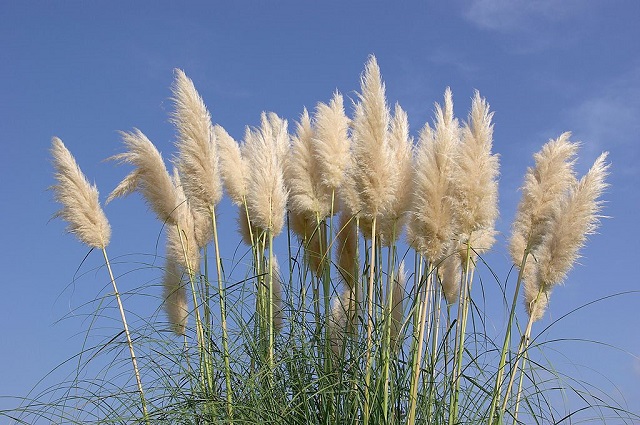
Photo: JLPC, CC BY-SA 3.0, via Wikimedia Commons
| Latin Name | Cortaderia selloana |
| Best time to see | August to October. |
| Distribution | Pampas grass can be found in many parts of the UK, although tends to grow near coastal regions. |
| Habitat | Prefers well-drained soils with lots of sun exposure. Often seen on rough grassland, sea-cliffs and roadsides. |
| Reproduction: | Reproduces by seeds. Pollinated by wind. |
| Uses | Aesthetic |
| Interesting fact | Although native to the UK, pampas grass is highly invasive in other countries and has been completely banned in places such as Hawaii and New Zealand, as it rapidly out-competes other plants. |
Marram Grass
Marram grass is a perennial grass species which can reach 1.2 m tall. It forms large clumps of erect stems with spiky leaves, and produces pale flower plumes.
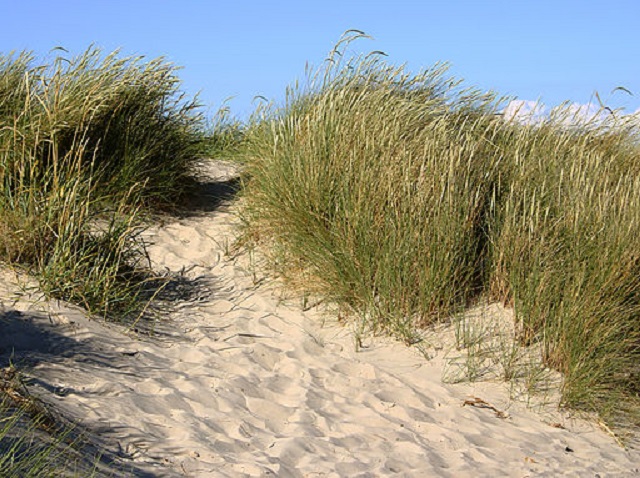
Malene Thyssen (User Malene), CC BY-SA 3.0, via Wikimedia Commons
| Latin Name | Ammophila arenaria |
| Best time to see | August to September. |
| Distribution | Marram grass can be found right around the UK coast. |
| Habitat | Coastal sand dunes are its primary habitat, though it may also be seen along coastal river banks. |
| Reproduction: | Reproduces by seeds and by rhizomes. Pollinated by wind. |
| Uses | Thatching, Basketry. |
| Interesting fact | Marram grass grows a network of thick rhizomes which help to bind sand together and maintain sand dune ecosystems. As such, it is often planted in areas prone to coastal erosion. |
Rough Meadow Grass
Rough meadow grass has slender stems which can grow to 60 cm in height. The leaves are narrow and tapering, while the stems produce short flower plumes.
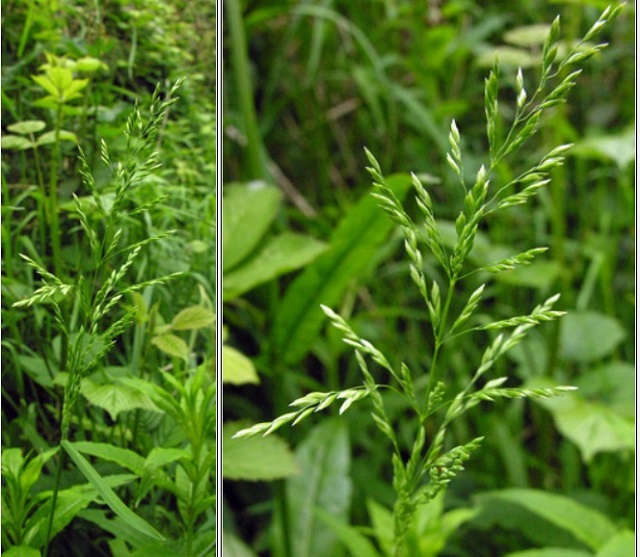
Photo Source: https://www.ukwildflowers.com/
| Latin Name | Poa trivialis |
| Best time to see | July to October. |
| Distribution | Rough meadow grass is common throughout the UK. |
| Habitat | Grows well in a range of habitats, including open woodland, meadows, wasteland and roadsides. It is also seen alongside streams. |
| Reproduction: | Reproduces by seeds and by stolons. Pollinated by wind. |
| Uses | Aesthetic |
| Interesting fact | The species name of kidney vetch – Rough meadow grass is a very adaptable species and is capable of growing well in polluted atmospheres. It is often considered a weed, especially in places such as golf courses, where it can be hard to eradicate. |
Sea Couch
Sea couch is a flowering grass with flat, hairy leaves and upright flower spikes. The flowers are small and pale, and the stems grow to around 1.2 m tall on average.
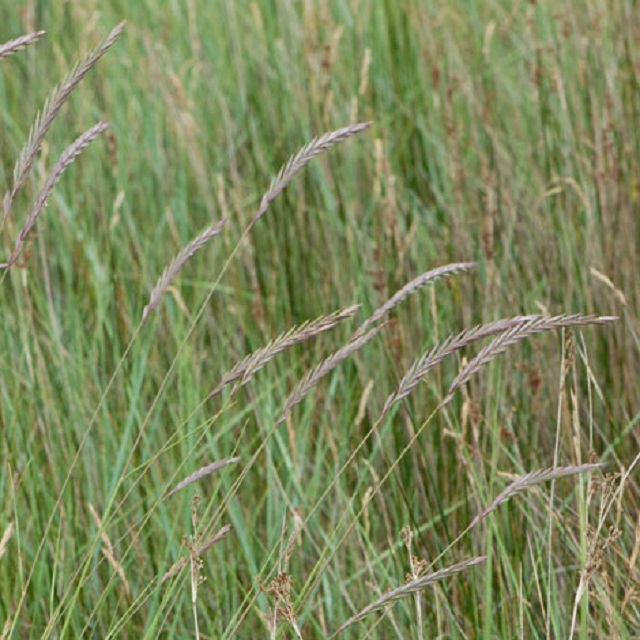 Photo Source: https://www.ukwildflowers.com/
Photo Source: https://www.ukwildflowers.com/
| Latin Name | Elytrigia atherica |
| Best time to see | June to August. |
| Distribution | Sea couch is mainly found in England and Wales, where it is distributed around the coast. |
| Habitat | Often grows on the margins of saltmarshes and streams, though it can also be seen on shingle beaches. |
| Reproduction: | Reproduces by seeds and by rhizomes. Pollinated by wind. |
| Uses | Medicine |
| Interesting fact | The dried rhizomes of sea couch used to be used as incense in medieval times in the UK, and they also have slight medicinal qualities for the treatment of fevers. |
Heathers
Bell Heather
Bell heather is a flowering plant named after its purple, bell-shaped flowers. The leaves are tiny and needle-like, while the stems are pinkish and grow to around 50 cm tall.
 Photo: Annette Meyer on Pixabay
Photo: Annette Meyer on Pixabay
| Latin Name | Erica cinerea |
| Best time to see | July to September. |
| Distribution | Bell heather is widespread in the UK, although it is most common in Scotland and Wales. It is generally absent from the East Midlands in England. |
| Habitat | Grows well on acidic soils in habitats such as peatland and heathland. It is also found on some calcareous grassland. |
| Reproduction: | Reproduces by seed. Pollinated by insects. |
| Uses | Fuel, Thatching. |
| Interesting fact | Bell heather is an important nectar source for many insects, including bees. Honey produced by the bees which pollinate bell heather is known as ‘heather honey’, and is dark and fragrant. |
Cornish Heath
Cornish heath is an evergreen shrub which can grow to heights of 90 cm. It has wiry stems and small, linear leaves. It produces globular flowers which are generally pink or lilac.

Photo: André Karwath aka Aka, CC BY-SA 2.5, via Wikimedia Commons
| Latin Name | Erica vagans |
| Best time to see | July to September. |
| Distribution | Cornish heath has a scattered distribution in the UK, but is most common in Cornwall and other areas of southern England |
| Habitat | Primarily a species of heathland habitats with well-drained soils. |
| Reproduction: | Reproduces by seed. Pollinated by insects. |
| Uses | Fuel, Thatching. |
| Interesting fact | Cornish heath is considered the floral emblem of Cornwall, due to this being one of the few places in the UK where the plant can be found. The acidic soils of the Cornish landscape aid its growth. |
Hyacinths
Common Bluebell
The common bluebell is a flowering plant with violet, bell-shaped flowers with up-rolled tips. The stems grow to 50 cm in height and have 3 – 6 linear leaves at their base.
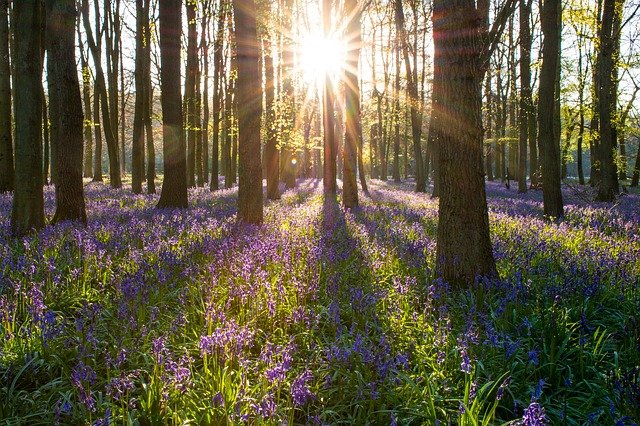
Photo: Greg Krycinski auf Pixabay
| Latin Name | Hyacinthoides non-scripta |
| Best time to see | April to May. |
| Distribution | Common bluebells are widespread in the UK, found everywhere except a few parts of northern Scotland. |
| Habitat | Thrives in ancient woodland, although can also be seen in hedgerows, meadows and sea-cliffs. |
| Reproduction: | Reproduces by seeds or by bulb. Pollinated by insects. |
| Uses | Aesthetic |
| Interesting fact | The common bluebell is widely regarded as the UK’s favourite flower. It beat all other species to take this crown in a 2004 survey organised by plant charity Plantlife. |
Spring Squill
Spring squill is a flowering plant known for its star-like blue flowers. It is generally small, only reaching 10 cm in height on average, and has curled, strap-like leaves that grow at the base of the plant.
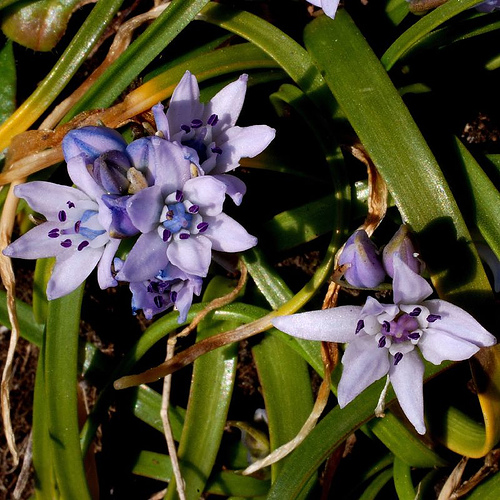
Photo: Andrew from Sheffield, UK, CC BY 2.0, via Wikimedia Commons
| Latin Name | Scilla verna |
| Best time to see | April to May. |
| Distribution | Spring squill is confined to coastal areas of the UK, mainly in northern and western parts. |
| Habitat | Grows well on coastal heathland and rocky slopes near the shore, as well as being found on exposed cliff-tops. |
| Reproduction: | Reproduces by seeds and by bulb. Pollinated by insects. |
| Uses | Aesthetic |
| Interesting fact | Due to its beauty, spring squill is often planted in parks and gardens as an ornamental plant. Its bulbs are toxic to humans however, so care should always be taken around them. |
Sages
Wild Thyme
An evergreen shrub, wild thyme has woody stems and grows as a wide mat to heights of about 5 cm. It has tiny, pointed leaves and produces clusters of purple flowers.
 Photo Source: https://www.ukwildflowers.com/
Photo Source: https://www.ukwildflowers.com/
| Latin Name | Thymus polytrichus |
| Best time to see | July to August. |
| Distribution | Wild thyme is relatively uncommon in the UK and is only found in a few coastal sites of eastern England and Wales. |
| Habitat | Prefers sandy heathland and grassland overlying chalk soils. It will also grow on inland dunes. |
| Reproduction: | Reproduces by seed. Pollinated by insects. |
| Uses | Food, Medicine, Essential Oils. |
| Interesting fact | The leaves and flower tops of wild thyme have a distinctive smell and are used to produce an essential oil which is popular in a variety of perfume and soaps. |
Borages
Forget-me-not
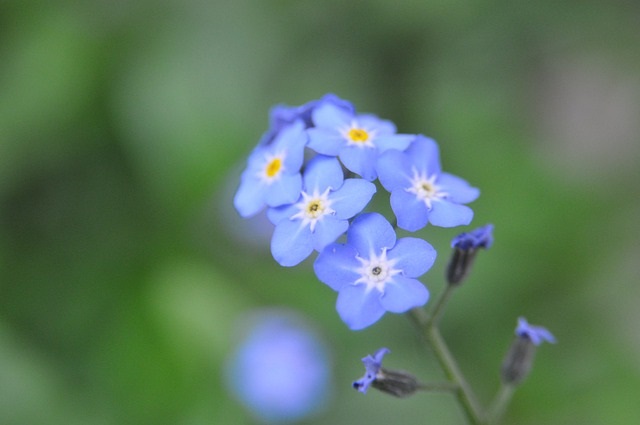
Photo: Gareth Bellamy on Pixabay
Forget-me-nots are perennial flowering plants with distinctive, five-lobed blue flowers. They grow to 30 cm tall and have hairy leaves.
The forget-me-not is cultivated widely throughout the world and is especially popular in gardens, where it attracts a range of nectar-loving insects such as bees and butterflies.
| Latin Name | Myosotis sylvatica |
| Best time to see | April to July. |
| Distribution | The forget-me-not can be found in much of the UK, although is generally uncommon in north-west Scotland. |
| Habitat | Often seen in damp woodland or rocky grassland, as well as cliff ledges. |
| Reproduction: | Reproduces by seed. Pollinated by insects. |
| Uses | Aesthetic |
| Interesting fact | The forget-me-not is cultivated widely throughout the world and is especially popular in gardens, where it attracts a range of nectar-loving insects such as bees and butterflies. |
Viper’s Bugloss
Viper’s bugloss is a tall flowering plant which grows to 80 cm in height, with a singular stem that produces many bell-shaped, blue flowers. The leaves are hairy and lance-shaped.
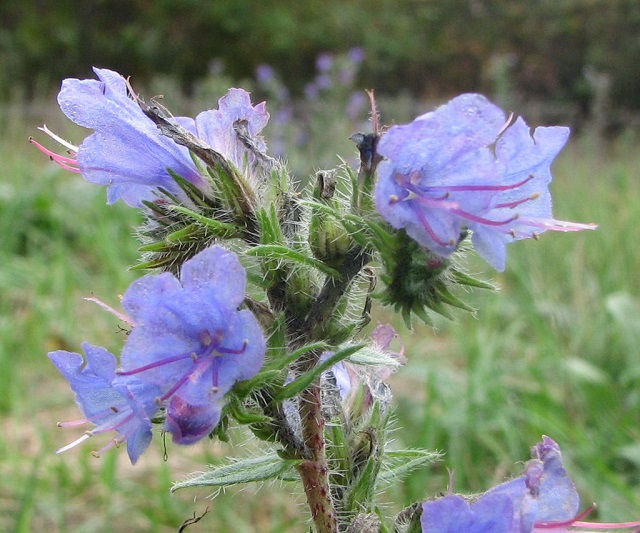
D. Gordon E. Robertson, CC BY-SA 3.0, via Wikimedia Commons
| Latin Name | Echium vulgare |
| Best time to see | May to July. |
| Distribution | Viper’s bugloss is most often seen in south-east England, although it also occurs in many parts of Wales, northern England and southern Scotland. |
| Habitat | Found in a range of habitats, although favours disturbed areas such as quarries and roadsides. It also grows on sea-cliffs and sand dunes. |
| Reproduction: | Reproduces by seed. Pollinated by insects. |
| Uses | Aesthetic. |
| Interesting fact | It is not known for sure how viper’s bugloss got its name, however it is likely due in part to the snake-skin pattern of its stem and the shape of its seeds, which resemble snake heads. |
Carnations
Sea Campion
Sea campions are low-growing flowering plants which reach 30 cm in height. They have waxy, lanceolate leaves and large, white flowers which are shaped like bells.
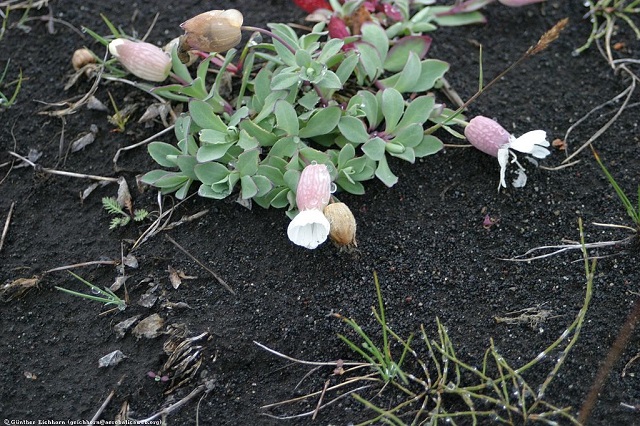
Photo: Geichhorn2000, CC BY-SA 3.0, via Wikimedia Commons
| Latin Name | Silene uniflora |
| Best time to see | June to August. |
| Distribution | A coastal species, the sea campion can be found right around the UK coastline, although is most common in western areas. |
| Habitat | Favours rocky sea-cliffs and coastal grassland, but can also grow well on sea walls or shingle beaches. |
| Reproduction: | Reproduces by seed. Pollinated by insects. |
| Uses | Aesthetic |
| Interesting fact | The genus name of the sea campion, Silene, comes from the Greek woodland god Silenus. This name stems from the Greek word for saliva, and it is associated with the campion family due to to some species producing a frothy foam that captures pollen from insects. |
Primroses
Scottish Primrose
The Scottish primrose is a low-growing flowering plant which can be recognised by its purple flowers with yellow centres. It grows to 8 cm tall and has large, veined leaves.
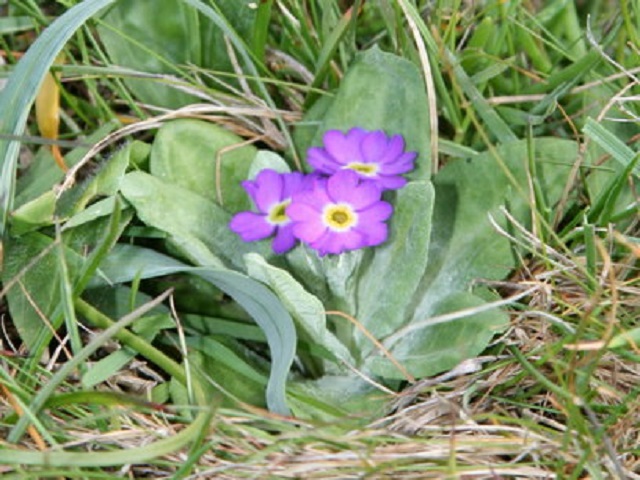
Photo: Helen Baker / Scottish Primrose
| Latin Name | Primula scotica |
| Best time to see | May to June. |
| Distribution | The Scottish primrose is endemic to northern Scotland, where it is mainly found along the north coastline. |
| Habitat | Grows well on coastal heathland and grassland, although it can also be seen on rocky outcrops. |
| Reproduction: | Reproduces by seed. Pollinated by insects. |
| Uses | Aesthetic |
| Interesting fact | The Scottish primrose requires short grass in order to grow and is therefore helped by the large numbers of sheep in Scotland, which keep larger growing plants in check. |
Irises
Yellow Iris
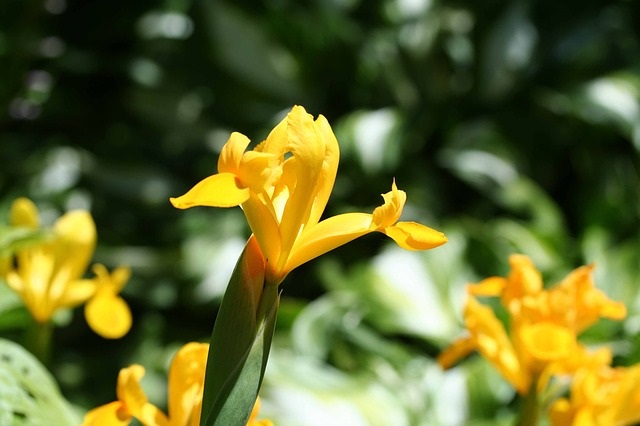 Photo: KitKestrel on Pixabay
Photo: KitKestrel on Pixabay
The yellow iris is a flowering plant with tall stems and sword-like leaves. Its flowers are large and yellow, and fold back on themselves to hang vertically. The plant can reach 1.5 m in height.
| Latin Name | Iris pseudacorus |
| Best time to see | May to August. |
| Distribution | Yellow irises can be found across much of the UK, with the exception of a few upland areas. |
| Habitat | Can be seen in wet meadows or along the edges of lakes, ponds and other water bodies. Also grows well in coastal habitats such as raised beaches. |
| Reproduction: | Reproduces by seeds and by rhizomes. Pollinated by insects. |
| Uses | Aesthetic |
| Interesting fact | The yellow iris is also known as the ‘Flag iris’ and is thought to be the inspiration for the fleur-de-lis symbol, due to its distinctive shape. This symbol is used widely in heraldry and by the Scouts. |
Bee Orchid
The bee orchid is a flowering plant named after the colourful lip of its flower, which is brown and yellow. The rest of the flower is light purple. The plant grows to 50 cm tall and has small rosettes of narrow leaves.
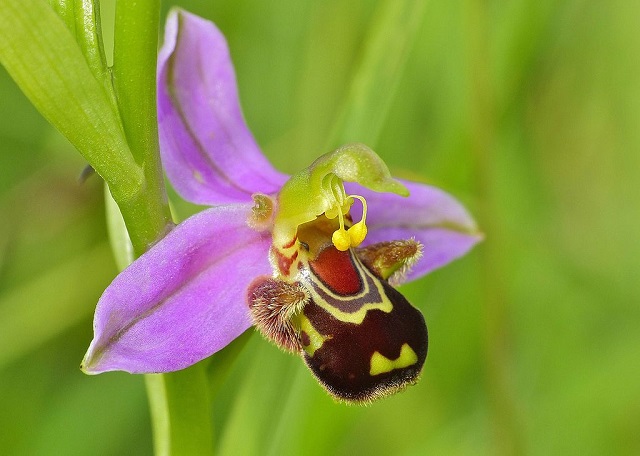
Photo: Bernard DUPONT from FRANCE, CC BY-SA 2.0, via Wikimedia Commons
| Latin Name | Ophrys apifera |
| Best time to see | June to July. |
| Distribution | Bee orchids are mainly found in the southern half of the UK, although a few grow in Northern Ireland and southern Scotland. |
| Habitat | Favours calcareous soils in dry habitats such as grassland, scrubland and sand dunes. |
| Reproduction: | Reproduces by seeds. Pollinated by insects. |
| Uses | Aesthetic |
| Interesting fact | The flower of the bee orchid is an example of sexually deceptive pollination. It resembles a bee to encourage true bees to try and mate with it. In doing so, they pick up pollen and pollinate the plant. |
Chalk Fragrant Orchid
The chalk fragrant orchid grows to around 30 cm tall on average and has long, lanceolate leaves. The flowers are usually pink or purple, and grow around a cylindrical flower spike.
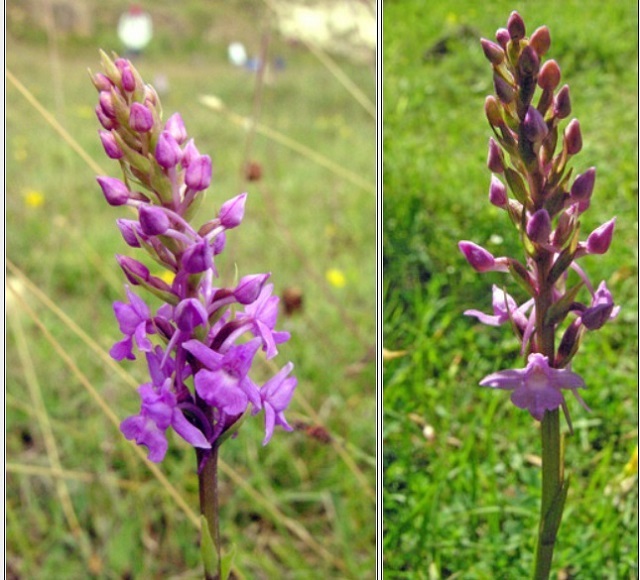
Photo Source: https://www.ukwildflowers.com/
| Latin Name | Gymnadenia conopsea |
| Best time to see | May to July. |
| Distribution | Chalk fragrant orchids are seen in many parts of the UK, though are more common in the south and are generally absent from northern Scotland. |
| Habitat | Mainly found on calcareous grassland, often in coastal regions. It also grows well in dune slacks. |
| Reproduction: | Reproduces by seeds. Pollinated by insects. |
| Uses | Food |
| Interesting fact | Chalk fragrant orchids have a very distinctive scent, which is often strongest during the evening. This is so that the flowers attract moths – the species’ main pollinator. |
Dune Helleborine
Dune helleborines are upright, flowering plants which can reach 1 m in height. They have broad leaves which grow in pairs, and small, green flowers with pinkish tips.
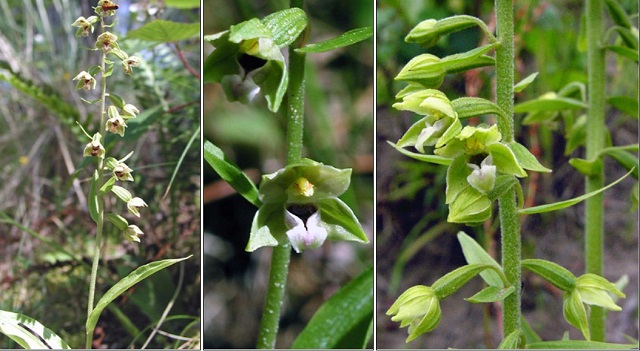
Photo Source: https://www.ukwildflowers.com/
| Latin Name | Epipactis dunensis |
| Best time to see | July to August. |
| Distribution | The dune helleborine occurs patchily in the UK, and is restricted to sites in Anglesey, Cumbria and southern Scotland. |
| Habitat | Primarily found in coastal grassland, though also does well in damp dune slacks. |
| Reproduction: | Reproduces by seeds. Pollinated by insects. |
| Uses | Aesthetic |
| Interesting fact | Dune helleborines have a very high tolerance for heavy metals, meaning they can thrive on abandoned waste tips left over from the UK’s industrial past. |
Early Purple Orchid
The early purple orchid is a slender flowering plant with a cluster of purple flowers that grows at the top of the stem. It reaches 60 cm in height and has shiny leaves with dark blotches.
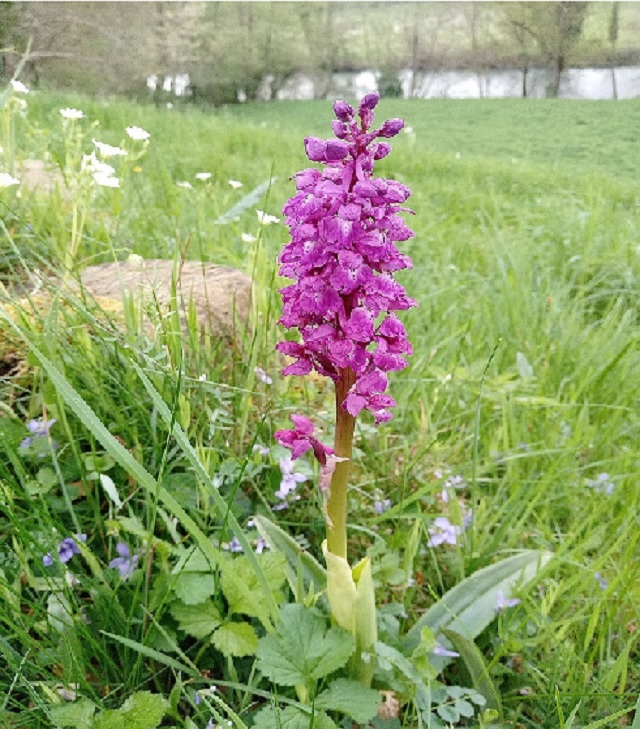
Photo: Patrice Bon, CC0, via Wikimedia Commons
| Latin Name | Orchis mascula |
| Best time to see | April to June. |
| Distribution | Early purple orchids are widespread in the UK, especially in southern regions. They are less common in north-east Scotland. |
| Habitat | Most frequently grows in woodland and calcareous grassland, although can also be seen in hedgerows and on sea-cliffs. |
| Reproduction: | Reproduces by seeds. Pollinated by insects. |
| Uses | Food |
| Interesting fact | The early purple orchid is so-called because it is the first native orchid species in the UK to flower. As it usually blooms during April or May, it heralds the coming of summer. |
Early Spider Orchid
The early spider orchid is a slender flowering plant known for the reddish-brown, velvety lip of its flower heads.
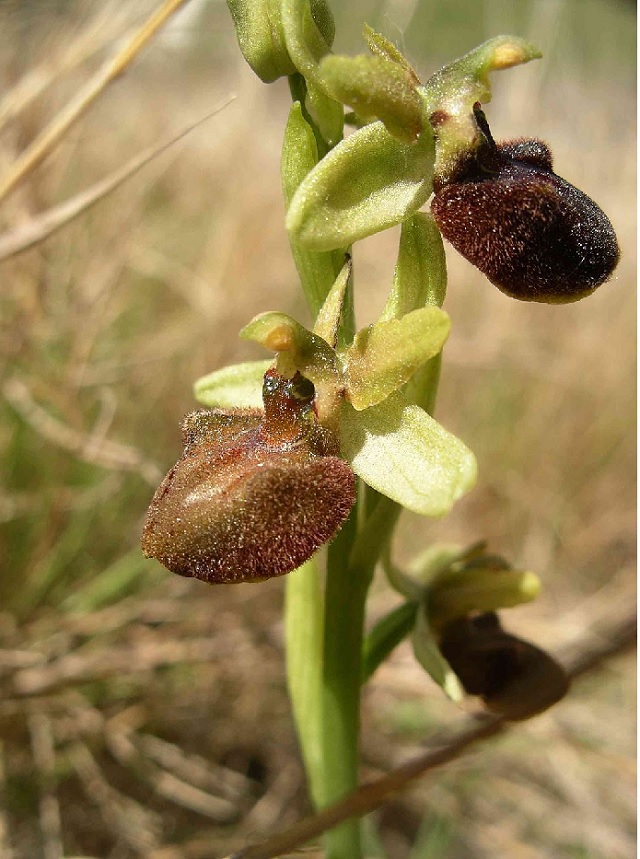
Photo: Velela, CC BY-SA 3.0, via Wikimedia Commons
| Latin Name | Ophrys sphegodes |
| Best time to see | March to April. |
| Distribution | The early spider orchid is mainly confined to the south coast of England. |
| Habitat | Grows well on heavily-grazed grassland, especially on chalk or limestone soils. It can also be found around quarries. |
| Reproduction: | Reproduces by seeds. Pollinated by insects. |
| Uses | Aesthetic |
| Interesting fact | The flowers of the early spider orchid closely resemble insects or spiders, hence the name of the plant. This lures in insects such as bees, which sometimes try to mate with the flowers and help to pollinate them as a result. |
Heath Spotted-orchid
The heath spotted-orchid is a slender flowering plant that grows with an erect stem to 70 cm tall. It produces many small flowers at the top of the stem, which are light pink to purple in colour.
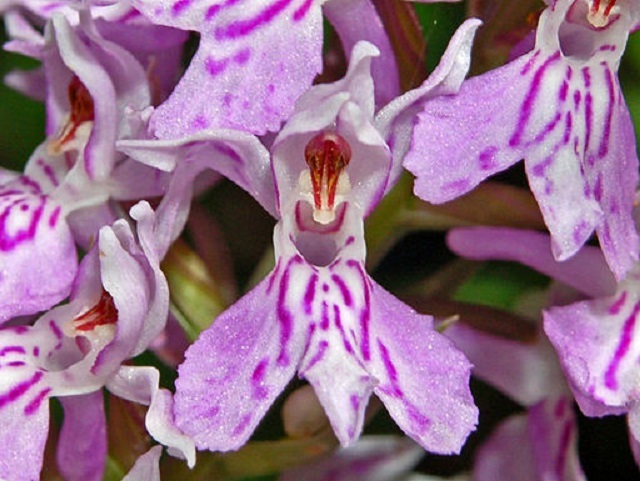
Photo: Hectonichus, CC BY-SA 3.0, via Wikimedia Commons
| Latin Name | Dactylorhiza maculata |
| Best time to see | June to August. |
| Distribution | Heath-spotted orchids are distributed throughout much of the UK, however they are most common in Wales and north-west Scotland. |
| Habitat | Favours acidic soils in habitats such as moorland, heathland and bog. Although it will also grow in grassland. |
| Reproduction: | Reproduces by seeds. Pollinated by insects. |
| Uses | Food |
| Interesting fact | The tubers of heath spotted-orchids can be ground into a fine powder known as salep. This starch-like substance is very sweet and it is said that one ounce of salep is enough to sustain a person for a whole day. |
Pyramidal Orchid
A distinctive flowering plant, the pyramidal orchid is named after the triangular shape of its pinkish-purple flower clusters. It can grow to 60 cm tall and has long, lanceolate leaves at its base.

Photo Source: https://www.ukwildflowers.com/
| Latin Name | Anacamptis pyramidalis |
| Best time to see | June to July. |
| Distribution | The pyramidal orchid can be found in much of England and Wales, although is most widespread in the south. Small populations can also be found in western Scotland. |
| Habitat | Prefers well-drained calcareous soils in areas of grassland, sea-cliffs and dune slacks. |
| Reproduction: | Reproduces by seeds. Pollinated by insects. |
| Uses | Food |
| Interesting fact | The scientific name Anacamptis comes from a Greek word that means 'bend forward' – a reference to the shape of the flower spur. |
Northern Marsh Orchid
The northern marsh orchid is a short, somewhat stumpy orchid that grows to 30 cm tall. The flowers are pinkish-purple and grow around a flattened flower spike, while the leaves are long and lanceolate.
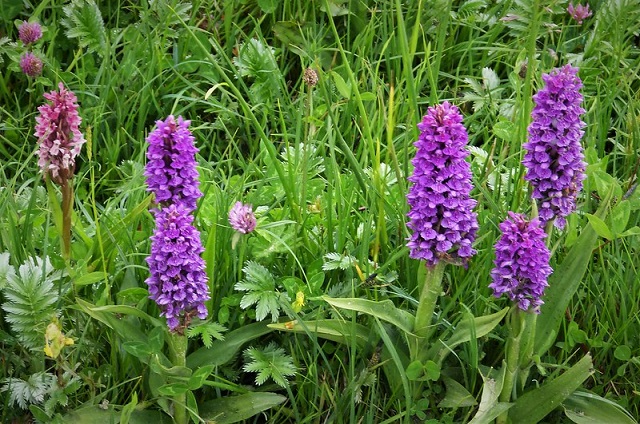
Image source: creative commons licensed (BY-NC-ND) flickr photo by gailhampshire
| Latin Name | Dactylorhiza purpurella |
| Best time to see | May to July. |
| Distribution | Northern marsh orchids are largely found in Scotland, Northern Ireland and northern parts of England and Wales. |
| Habitat | Often seen in dune slacks, as well as in wet meadows, marshes and verges. It is also common in quarries. |
| Reproduction: | Reproduces by seed. Pollinated by insects. |
| Uses | Aesthetic |
| Interesting fact | The northern marsh orchid is difficult to distinguish from other marsh orchids and was not recognised as a separate species until as recently as 1920. |
Southern Marsh Orchid
The southern marsh orchid grows to 70 cm tall and has long, lanceolate leaves that are generally unspotted. The flowers are dark pink or purple and grow around a slender flower head.
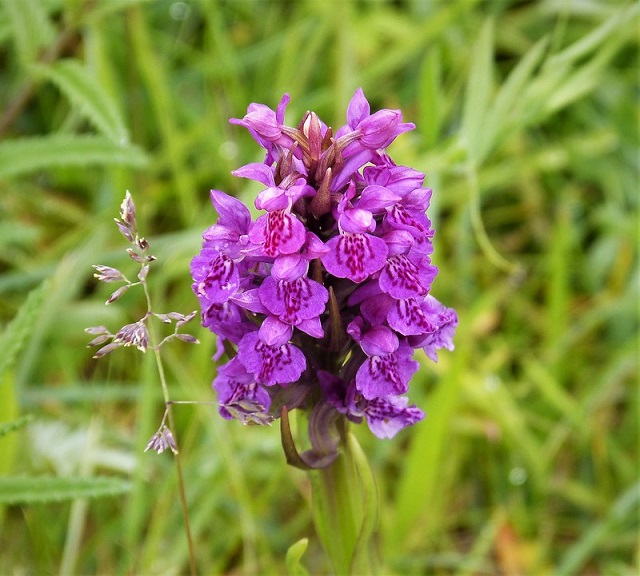
Image source: creative commons licensed (BY-NC-ND) flickr photo by gailhampshire
| Latin Name | Dactylorhiza praetermissa |
| Best time to see | May to July. |
| Distribution | The southern marsh orchid is confined to Wales, the Midlands and southern England. |
| Habitat | Grows well in damp habitats such as meadows, dune slacks and marshes. It can also be found along roadsides |
| Reproduction: | Reproduces by seed. Pollinated by insects. |
| Uses | Aesthetic |
| Interesting fact | Southern marsh orchids have a symbiotic relationship with certain types of fungus. The fungi grow in the root system of the plant and provide it with extra nutrients. |
Olives
Wild Privet
The wild privet is a deciduous shrub that grows to about 3 m tall, with woody stems. It produces black berries and small, white flowers, together with lanceolate leaves.
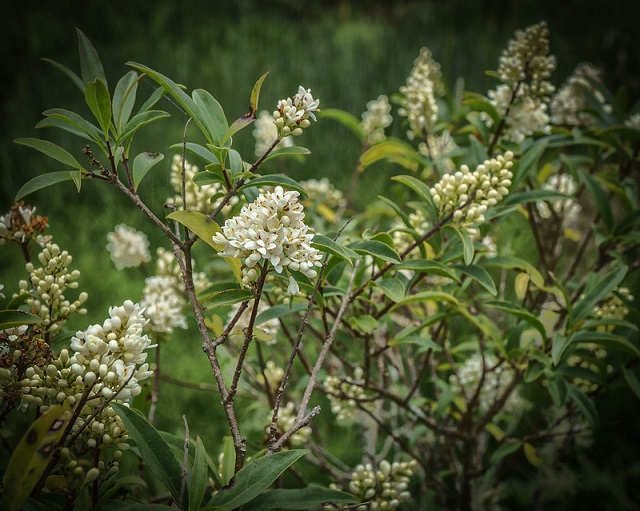
Image source: flickr photo by Carol Jacobs-Carre
| Latin Name | Ligustrum vulgare |
| Best time to see | June to August. |
| Distribution | Wild privets are distributed across much of the UK, although are generally absent from north-west Scotland. |
| Habitat | Grows well in hedgerows, woodland and scrub, especially on well-drained soils. |
| Reproduction: | Reproduces by seeds. Pollinated by insects. |
| Uses | Hedging |
| Interesting fact | The berries of wild privet are extremely poisonous to humans. Despite this, they are an important food for birds such as thrushes and blackbirds. |
Pines
Juniper
The juniper is an evergreen tree which can grow to 10 m in height and has thin, spiky needles. It produces purple, berry-like cones.
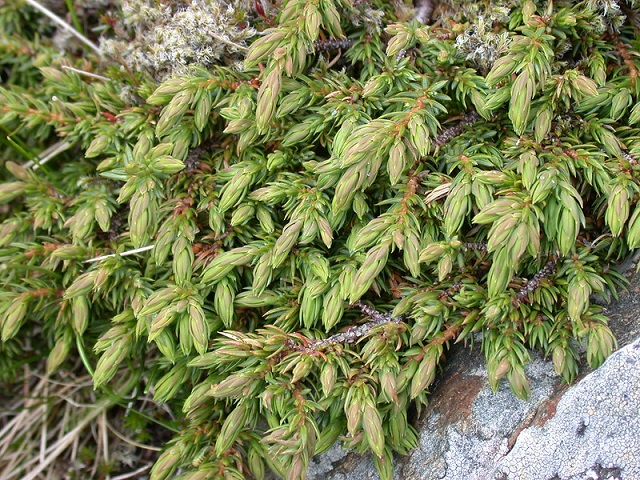 Image source: flickr photo by Len Worthington
Image source: flickr photo by Len Worthington
| Latin Name | Juniperus communis |
| Best time to see | March to May. |
| Distribution | unipers occur patchily in the UK but are most common in Scotland, northern England and southern England. |
| Habitat | Primarily seen on acidic soils, but occurs in a range of habitats including heathland, chalk downs and rocky coastal areas. |
| Reproduction: | Reproduces by seeds. Pollinated by wind. |
| Uses | Wood, Food, Gin. |
| Interesting fact | In the past, juniper was considered to be a deterrent against the Devil and witches. It was sometimes burnt on Halloween to ward off evil spirits. |
Maritime Pine
The maritime pine is an evergreen tree which produces large pine cones and very long needles. The branches are woody and the plant grows to a maximum height of 35 m tall.
| Latin Name | Pinus pinaster |
| Best time to see | May to August. |
| Distribution | The maritime pine is patchily distributed in the UK but can be found on coastlines throughout the southern half of the country. |
| Habitat | Prefers lowland coastal habitats. |
| Reproduction: | Reproduces by seeds. Pollinated by wind. |
| Uses | Wood, Resin. |
| Interesting fact | The resin from maritime pines is an important source of turpentine, which is commonly used to produce paint-thinner, varnish or furniture wax. |
European Black Pine
European black pines are tall coniferous trees that can reach 50 m in height. They have thin needles, scaly bark and they produce large seed cones.
| Latin Name | Pinus nigra |
| Best time to see | May to August. |
| Distribution | European black pines are widespread in the UK but are more common in the south. |
| Habitat | Often seen in plantations, parks and gardens. It also grows well on coastal heathland and dunes. |
| Reproduction: | Reproduces by seeds. Pollinated by wind. |
| Uses | Wood, Resin. |
| Interesting fact | Large numbers of microorganisms live within the The European black pine is a fast-growing tree and can sometimes gain as many as 24 inches in height per year. It lives to over 500 years old. |
Scot’s Pine
The Scot’s pine is an evergreen tree with a long, bare trunk and scaly bark. It has bluish-green needles and produces large seed cones, growing to 35 m in height.

Photo Source: https://www.ukwildflowers.com/
| Latin Name | Pinus sylvestris |
| Best time to see | May to August. |
| Distribution | The Scot’s pine can be found almost everywhere in the UK. |
| Habitat | Grows particularly well in sandy or stony soils, though is also common in boggy areas and heathland. It is planted widely in woodland. |
| Reproduction: | Reproduces by seeds. Pollinated by wind. |
| Uses | Wood, Resin. |
| Interesting fact | The Scot’s pine is the only pine tree species that is truly native to the UK. It is an important constituent of Caledonian pine forest – one of the country’s most threatened habitats. |
Willows
Creeping Willow
The creeping willow is a deciduous shrub that initially grows upright and then spreads laterally. It reaches 1 m in height and produces small, rounded leaves and tiny yellow flowers within catkins.

Photo: Sten Porse, CC BY-SA 3.0, via Wikimedia Commons
| Latin Name | Salix repens |
| Best time to see | April to May. |
| Distribution | Creeping willows can be seen around much of the UK, though are less common in central England. |
| Habitat | Favours coastal areas such as fixed dunes or dune slacks, but will also grow in heathland and grassland. |
| Reproduction: | Reproduces by seeds. Pollinated by wind. |
| Uses | Aesthetic |
| Interesting fact | There are many variations of creeping willow in the UK. Some grow as small hairless plants low to the ground, while others grow erect as silky-leaved shrubs. |
Beeches & Oaks
European Beech
The European beech is a deciduous tree with rounded, slightly hairy leaves and tassel-like catkins. It produces beech nuts and grows to a height of around 40 m.

Photo Source: https://www.ukwildflowers.com/
| Latin Name | Fagus sylvatica |
| Best time to see | April to May. |
| Distribution | The European beech can be found almost everywhere in the UK. |
| Habitat | Grows well in a variety of soils and is a common sight in woodlands and hedgerows, as well as parks. |
| Reproduction: | Reproduces by seeds. Pollinated by wind. |
| Uses | Wood, Food. |
| Interesting fact | The European beech is often considered the queen of British trees and has long been associated with femininity. |
European Oak
The European oak is a flowering, deciduous tree that grows to 40 m tall. It forms a broad crown of round-lobed leaves, together with yellow catkins and small acorn fruits.
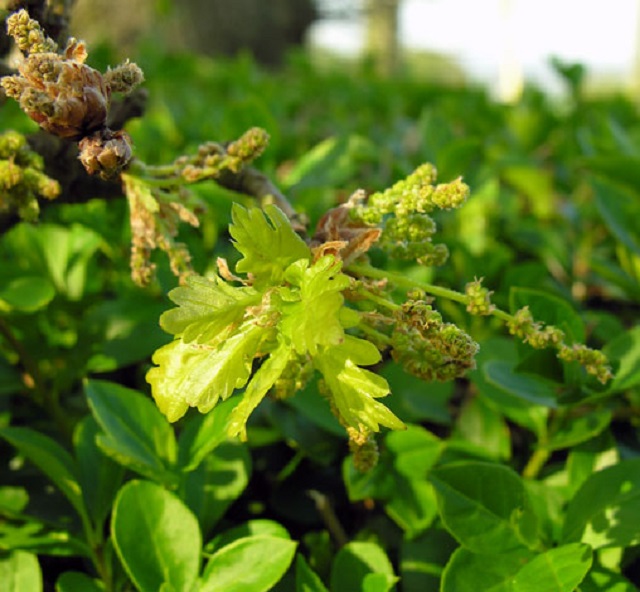
Photo Source: https://www.ukwildflowers.com/
| Latin Name | Quercus robur |
| Best time to see | April to May. |
| Distribution | The European oak is distributed across almost the whole of the UK, absent only from the far north of Scotland. |
| Habitat | Widely planted in woodland and hedgerows, but grows well on a range of soils and is typical of ancient forest habitats. |
| Reproduction: | Reproduces by seeds. Pollinated by wind. |
| Uses | Wood, Food, Medicine. |
| Interesting fact | The European oak is a very long-lived species, capable of surviving for more than 1,500 years. It is also the thickest tree species in the UK, with one tree known to have a circumference of 12.2 m. |
